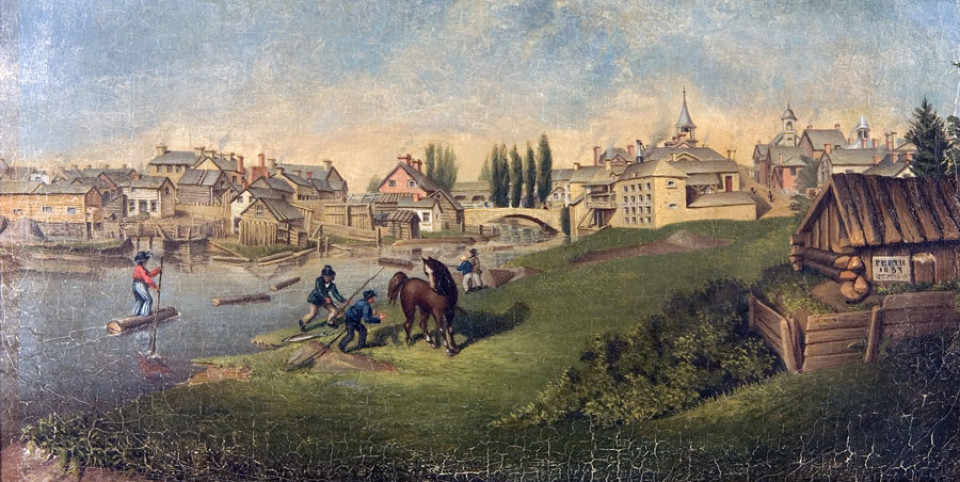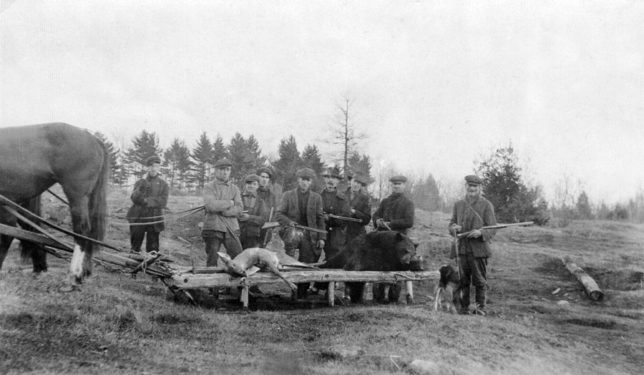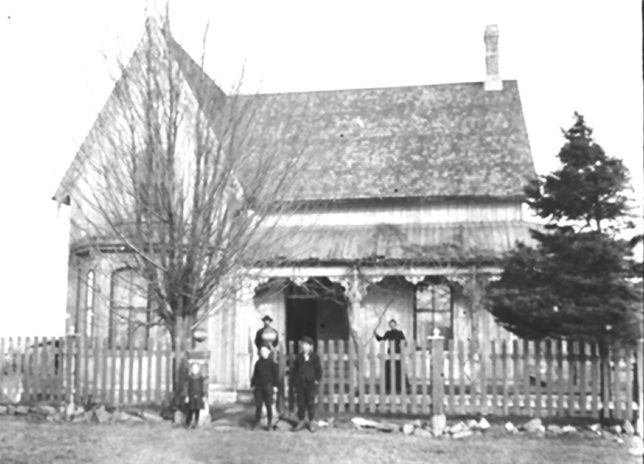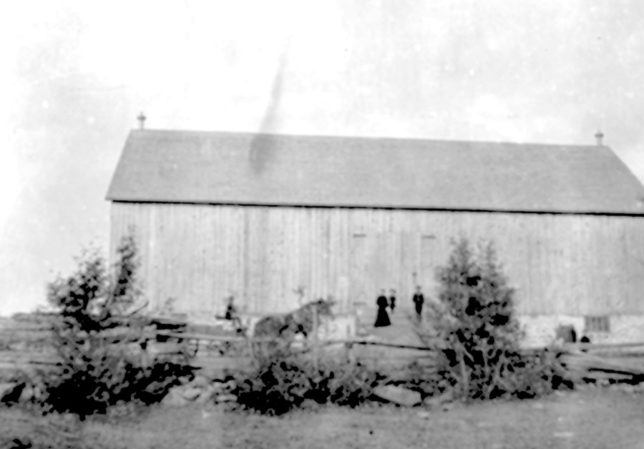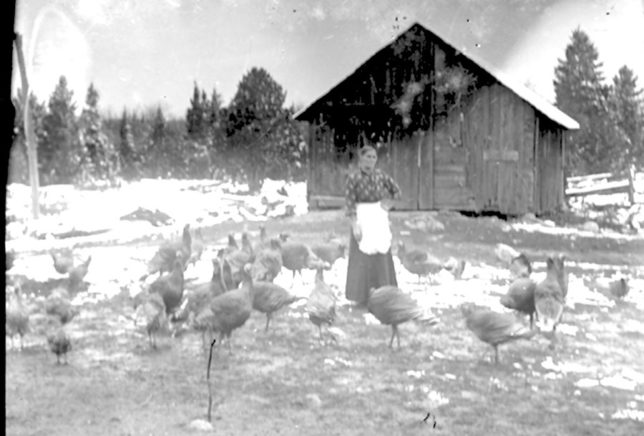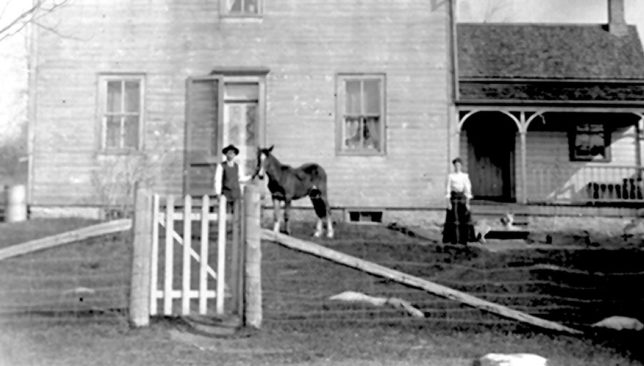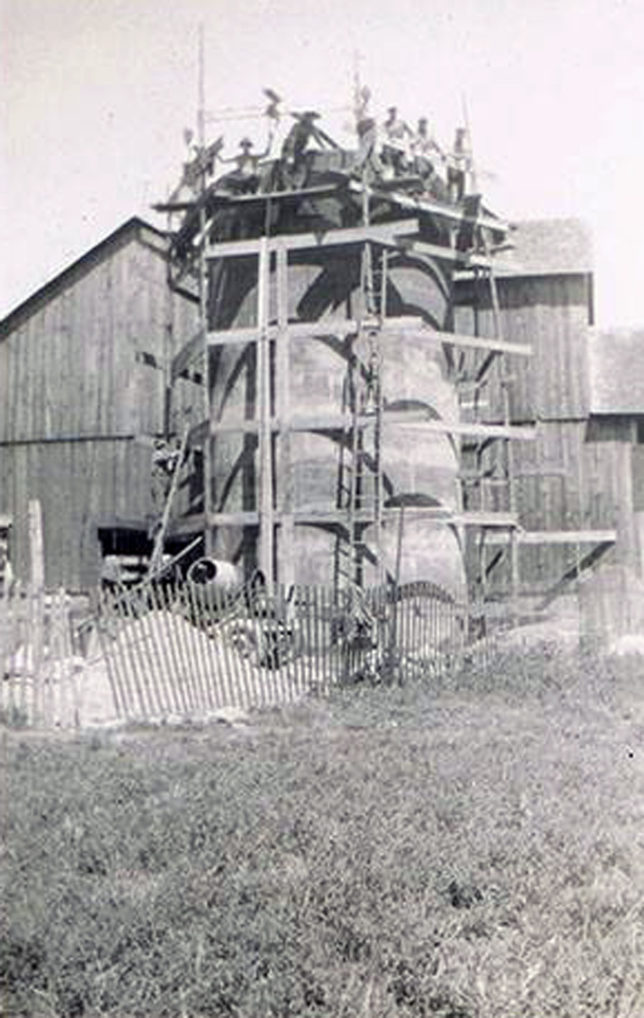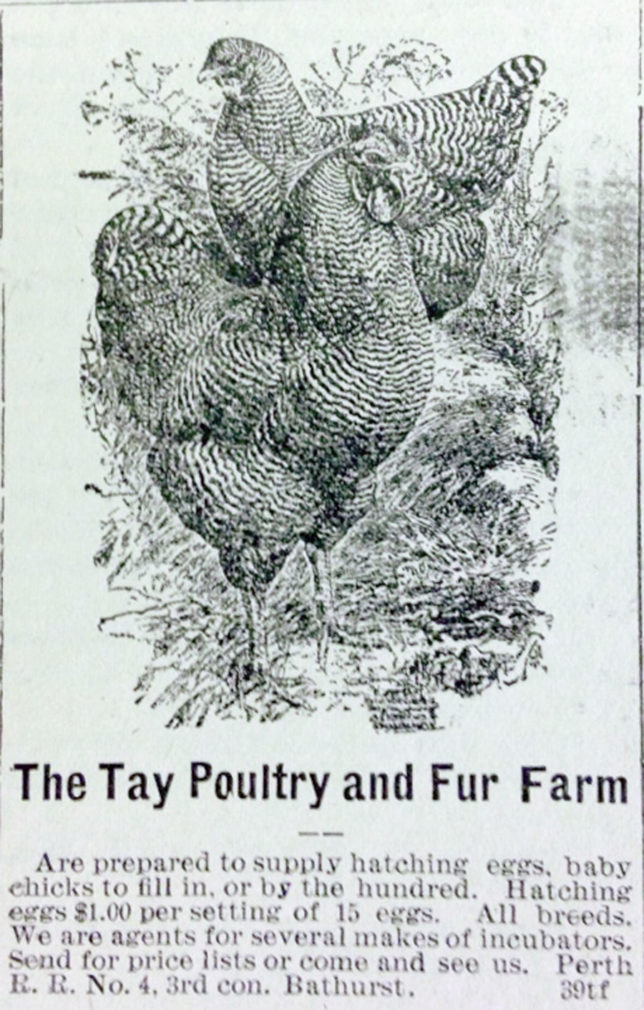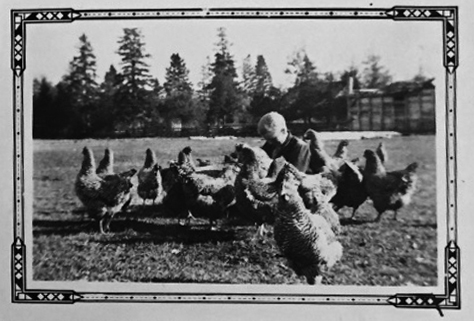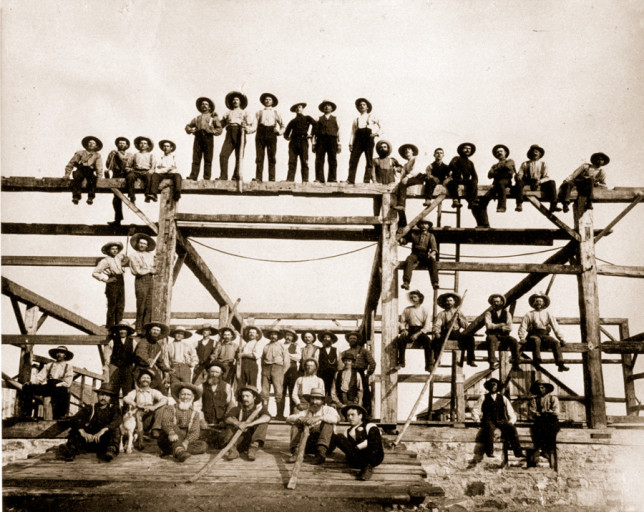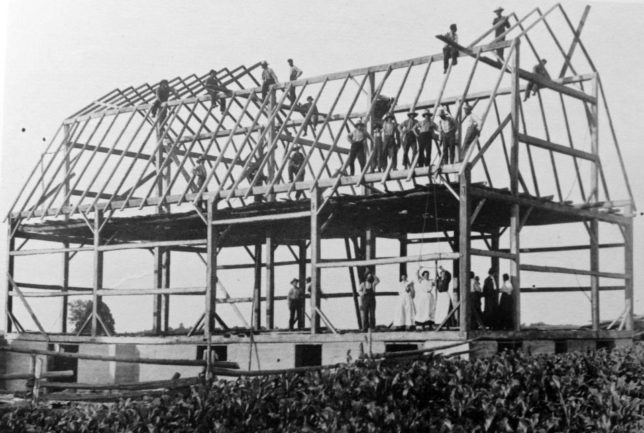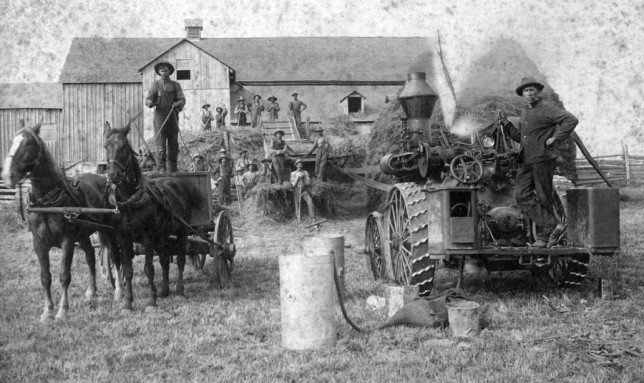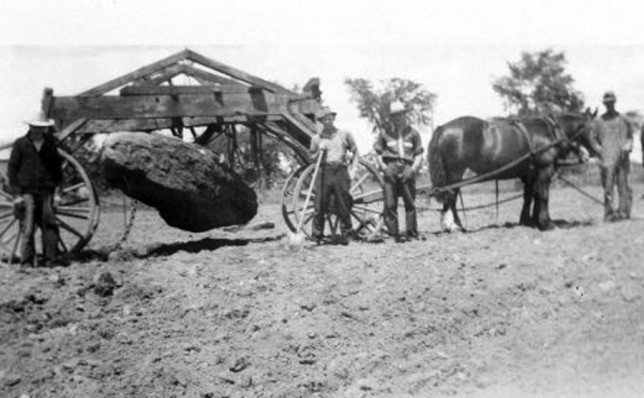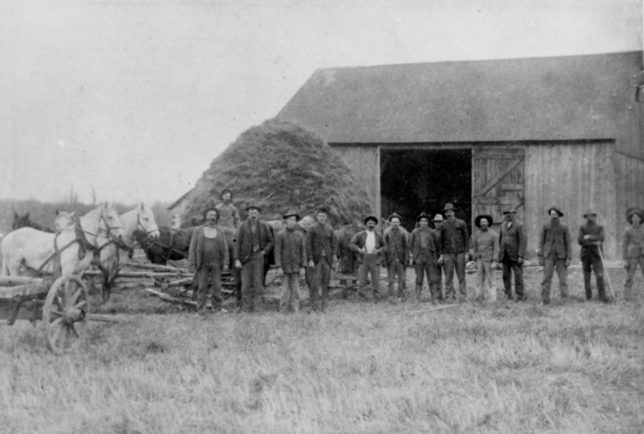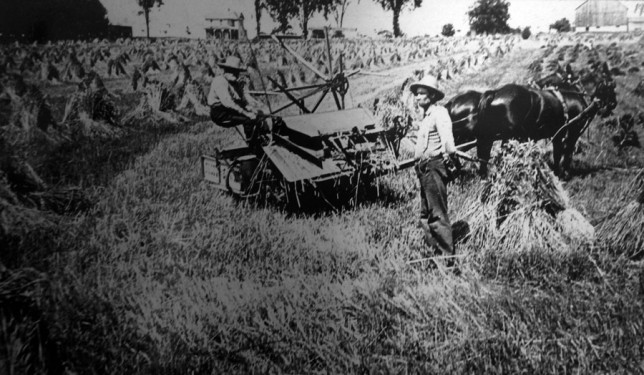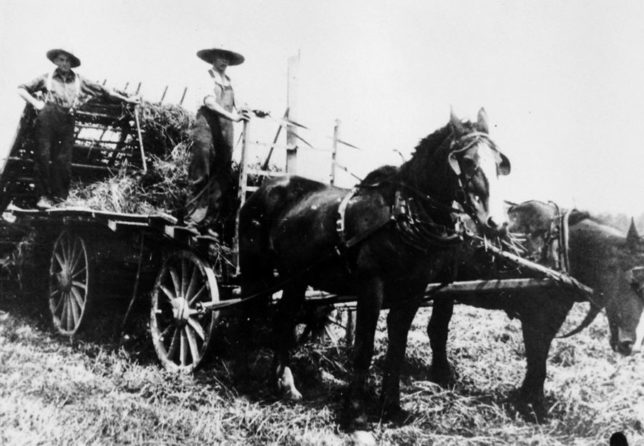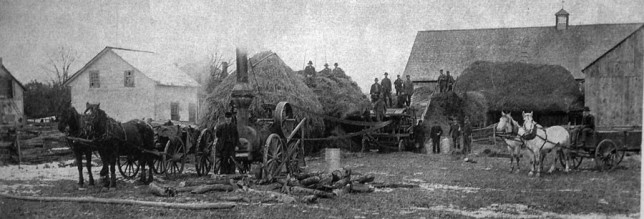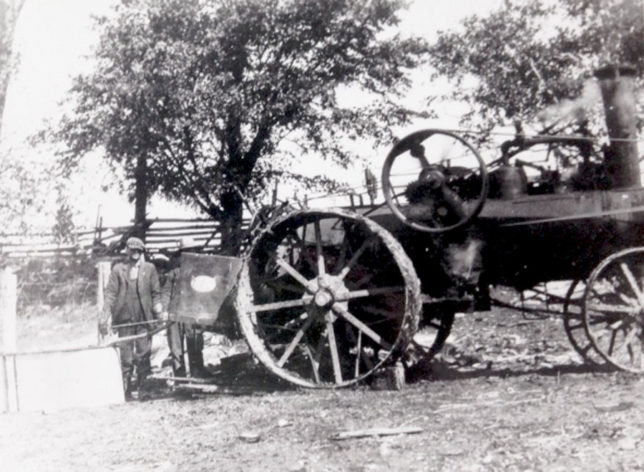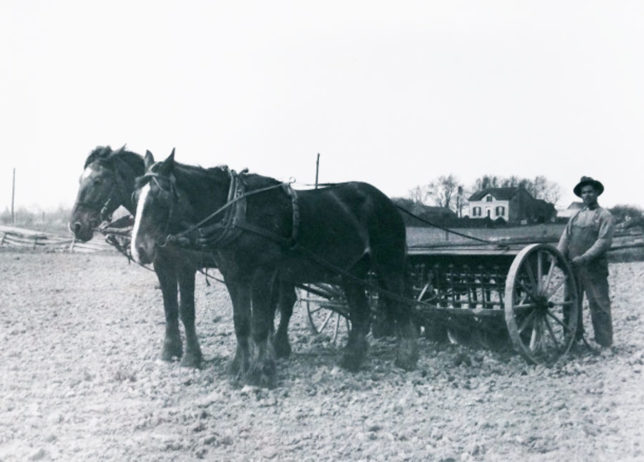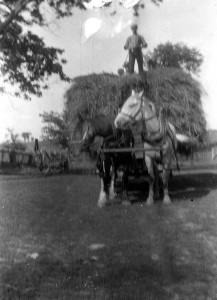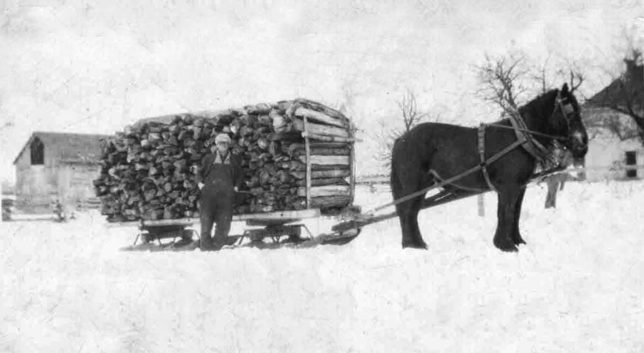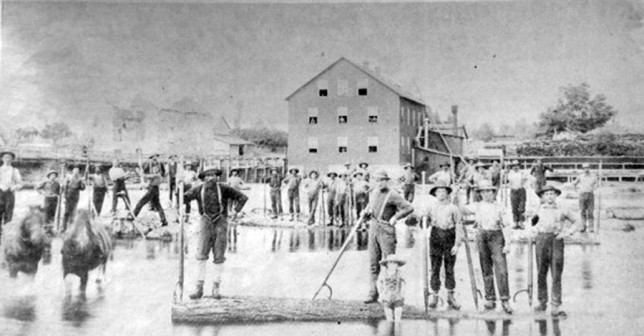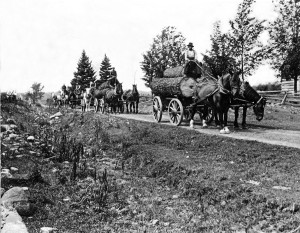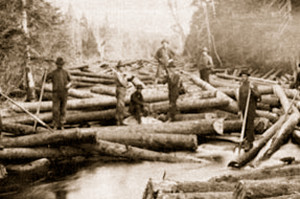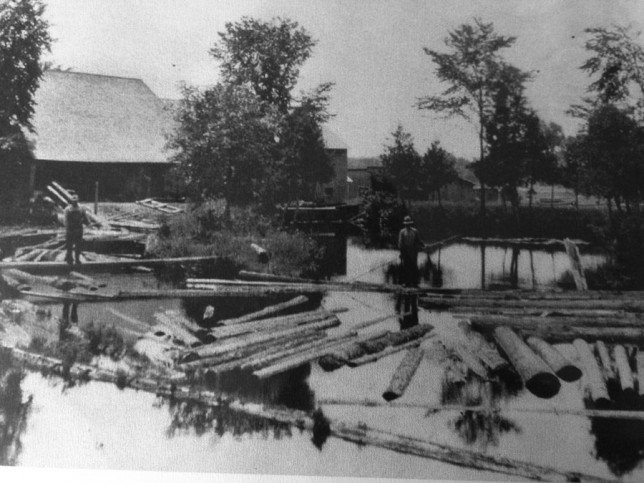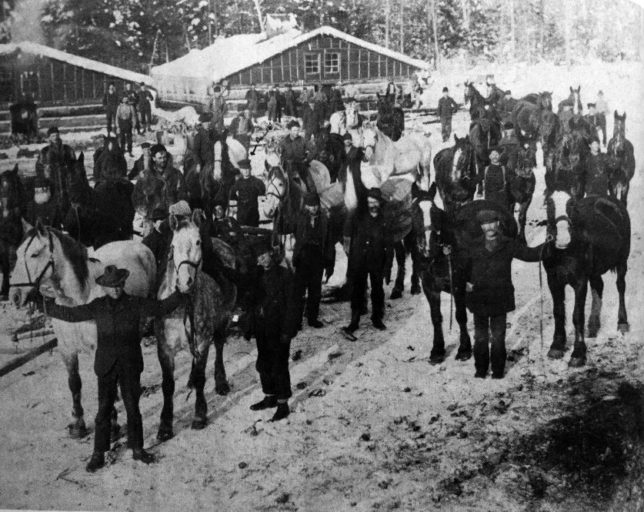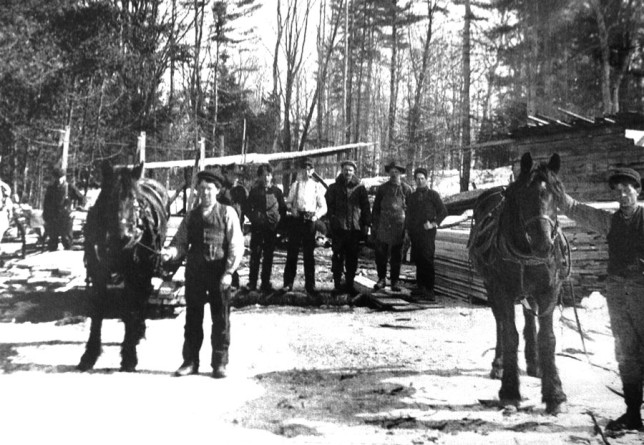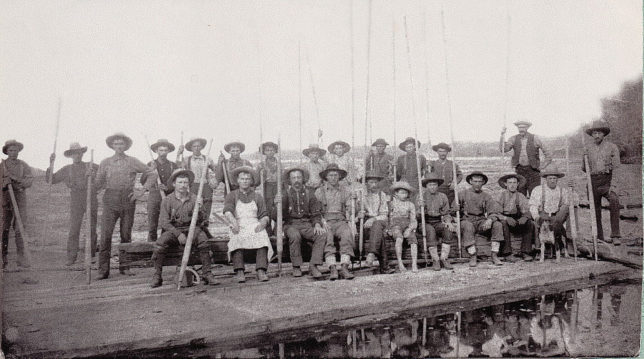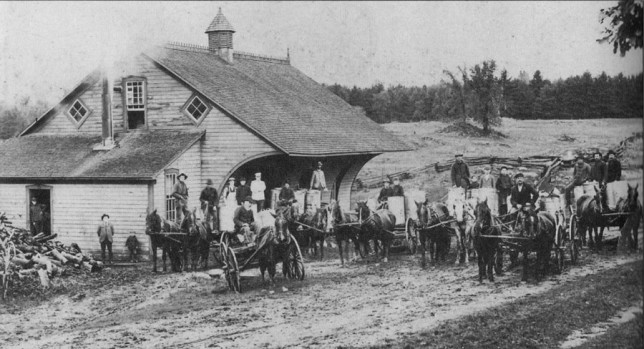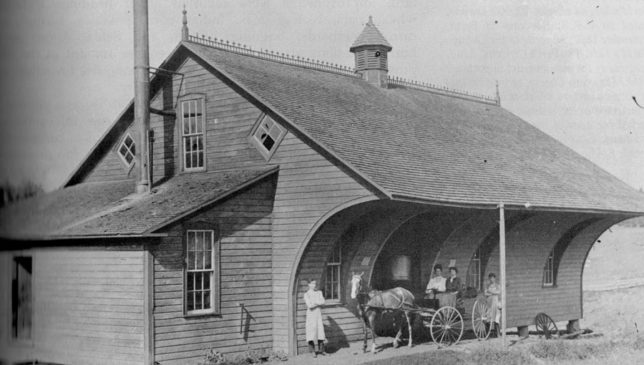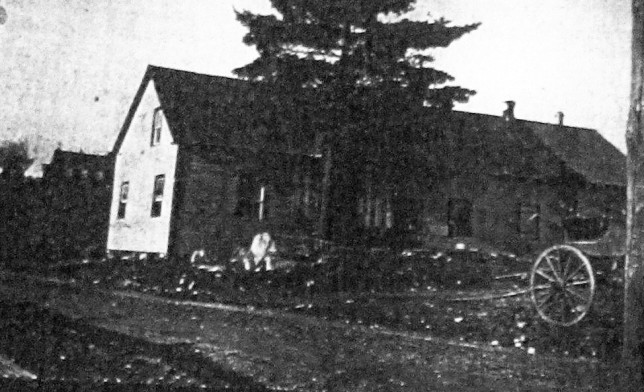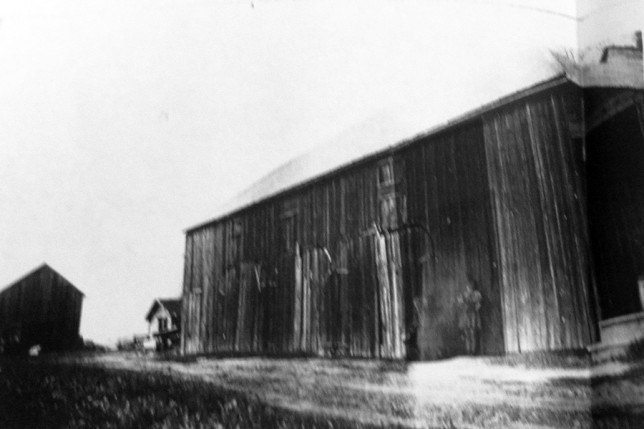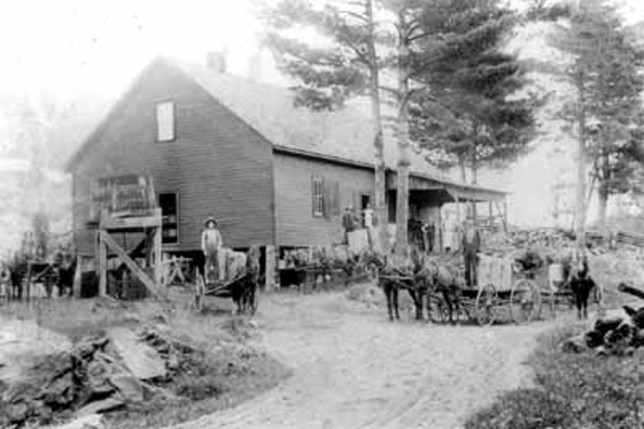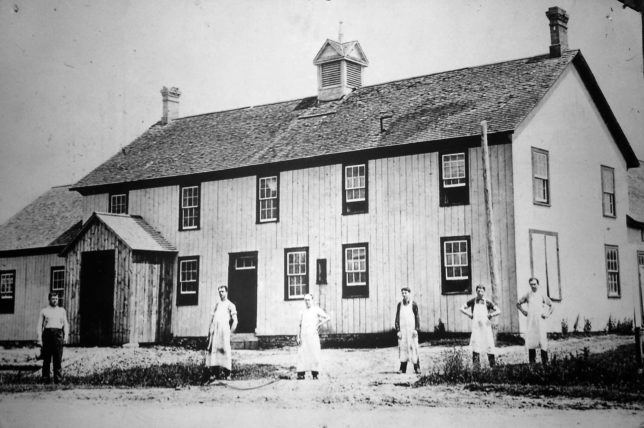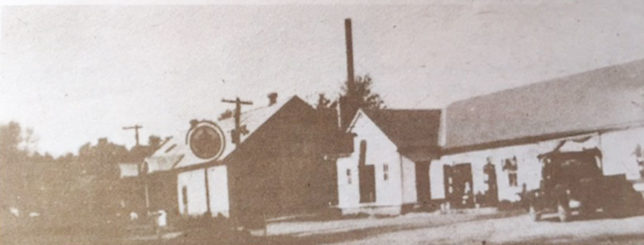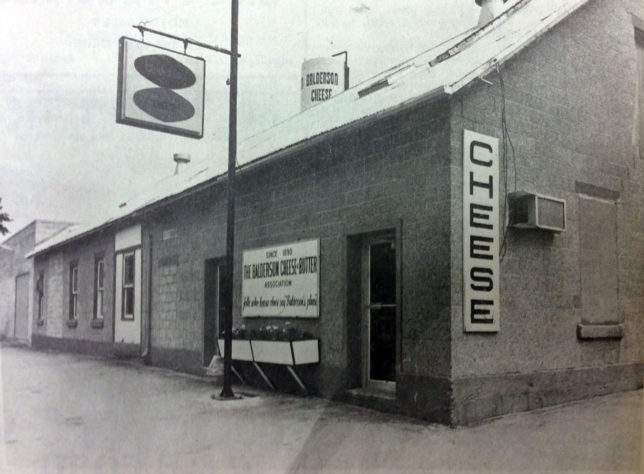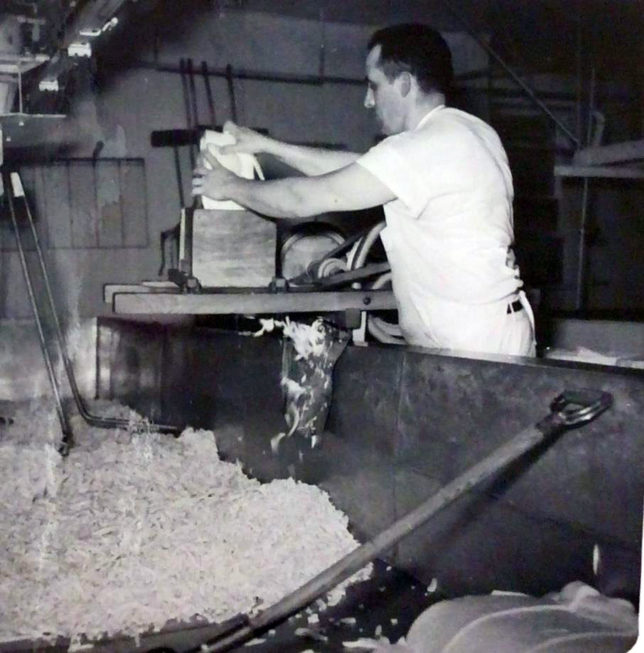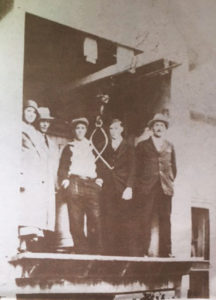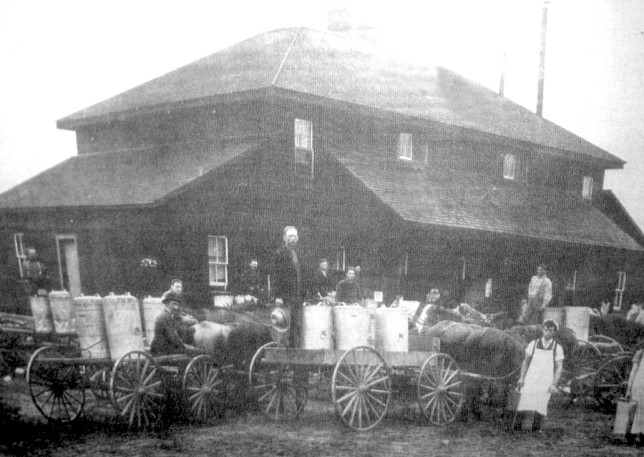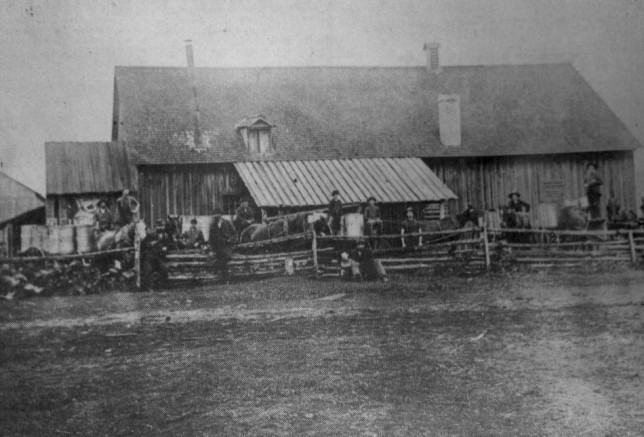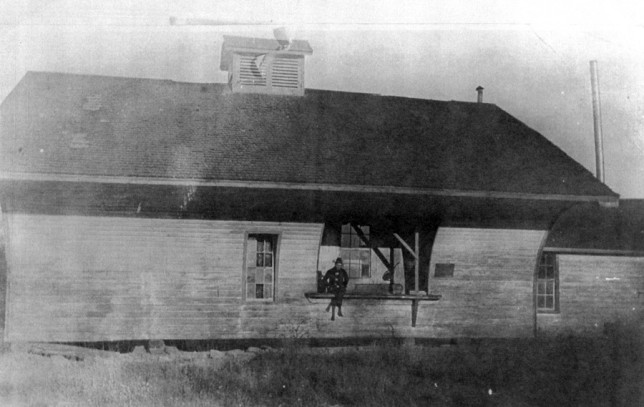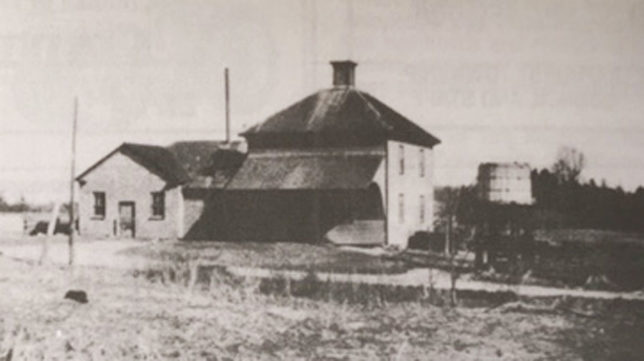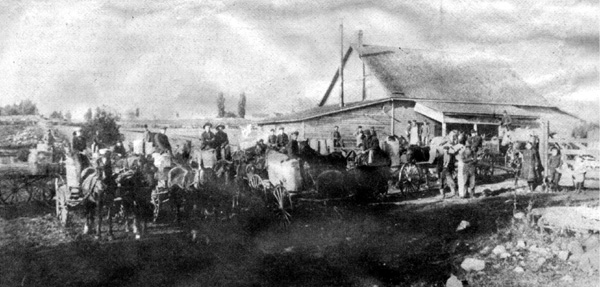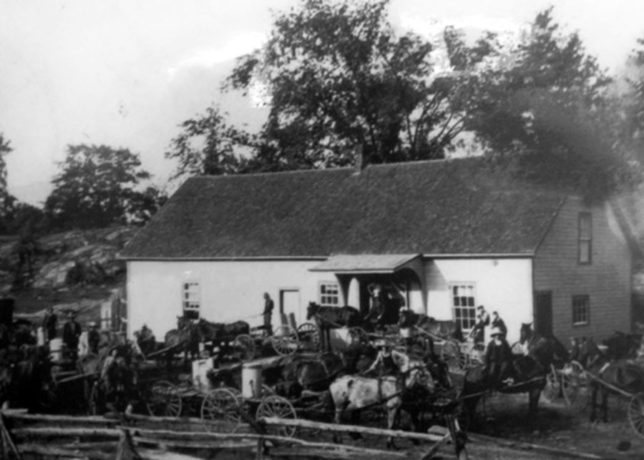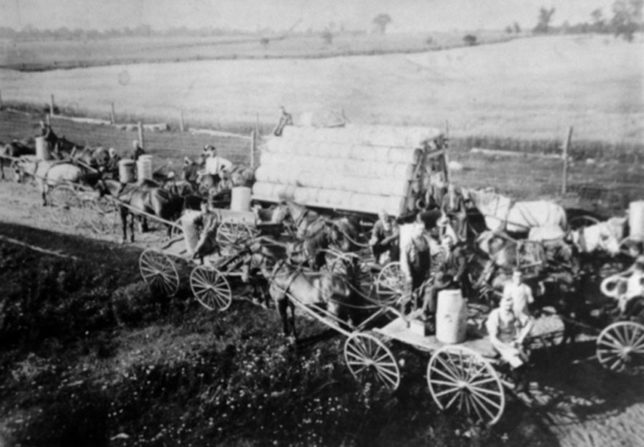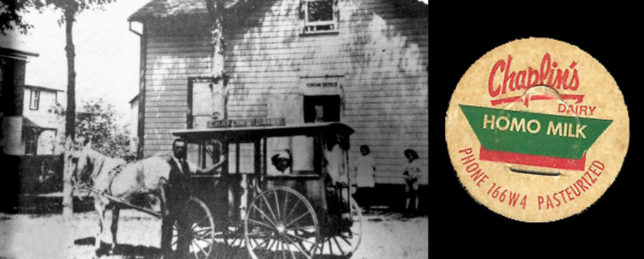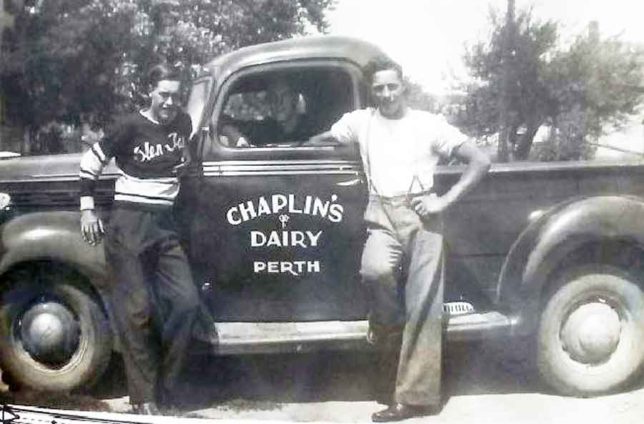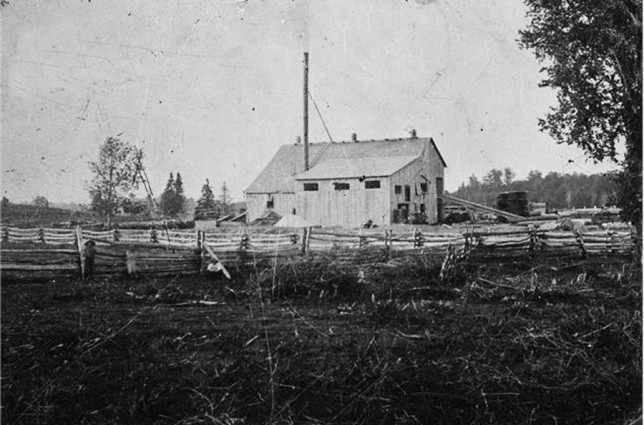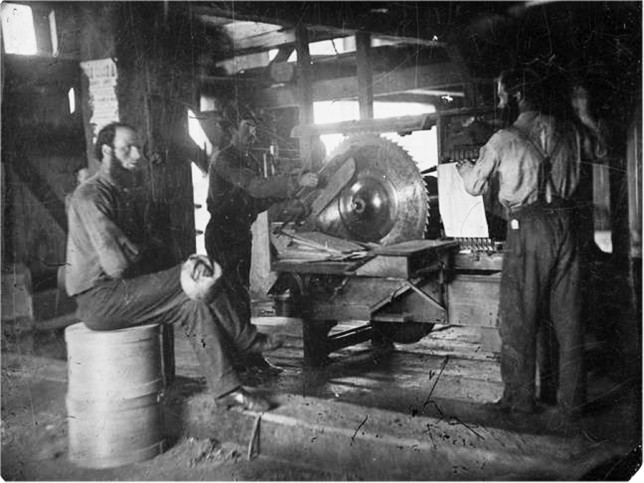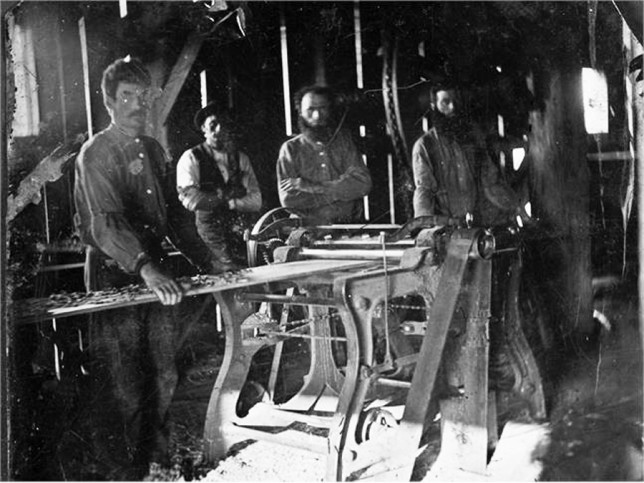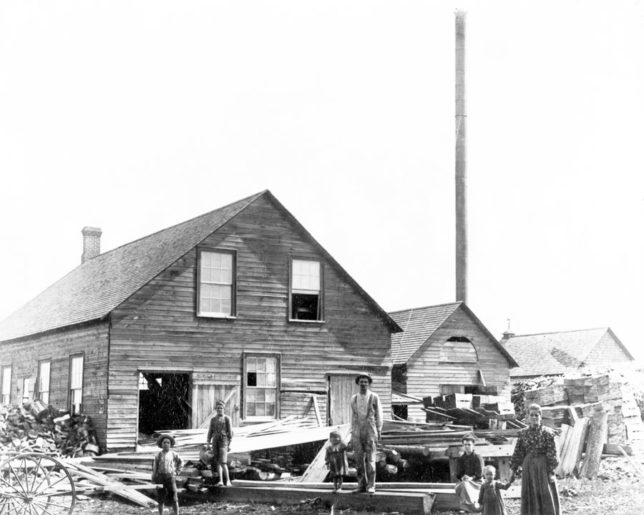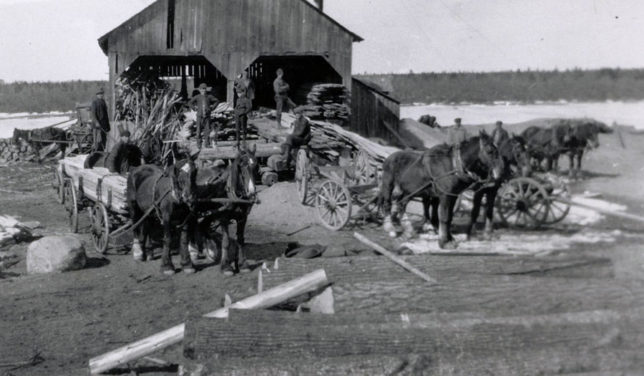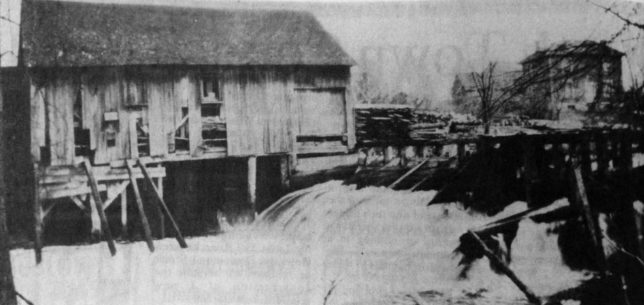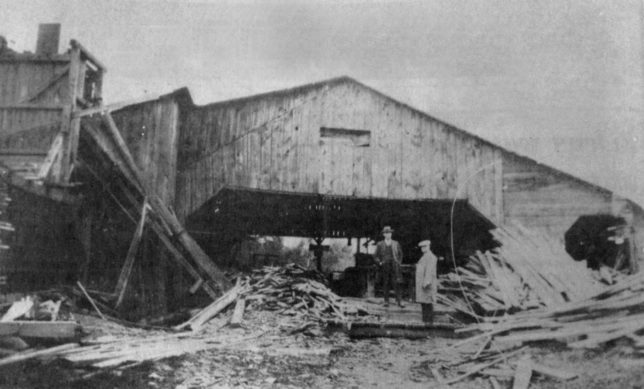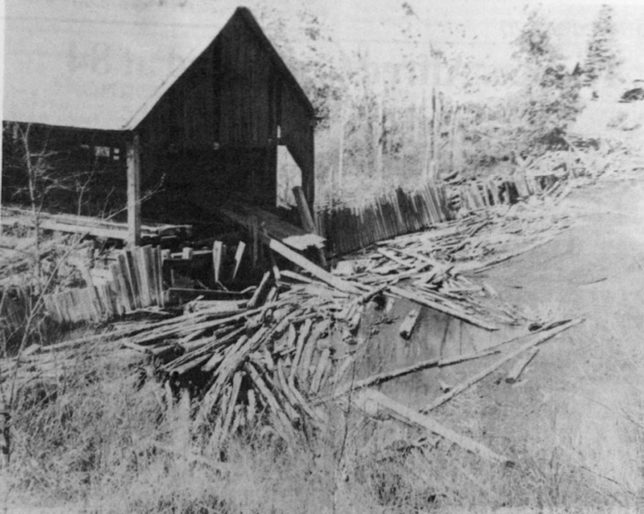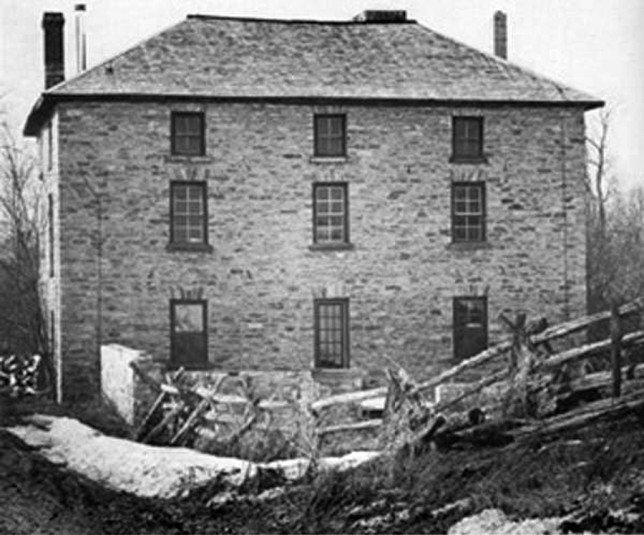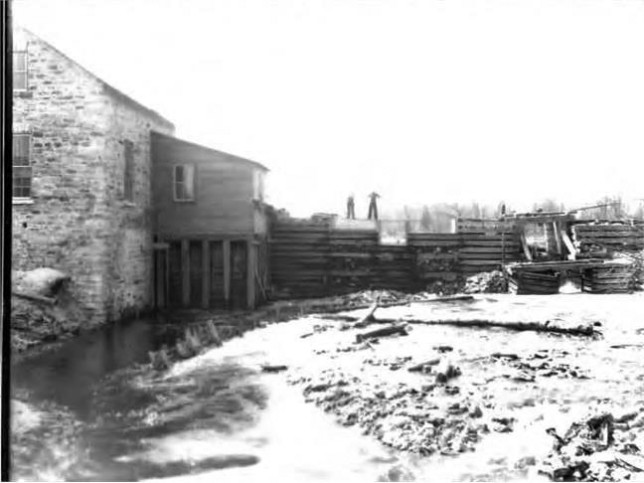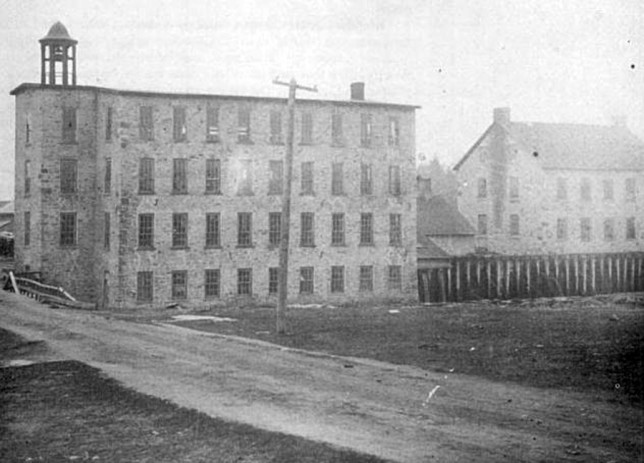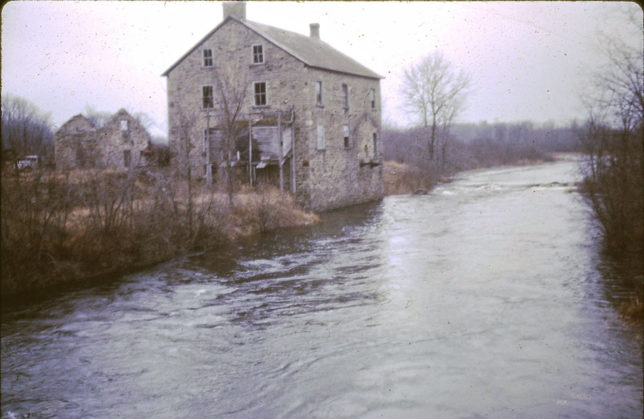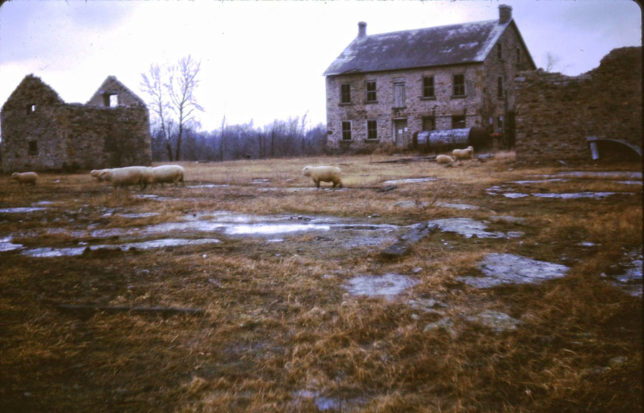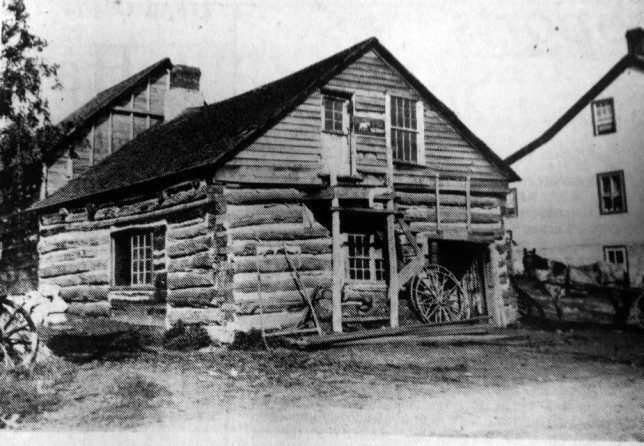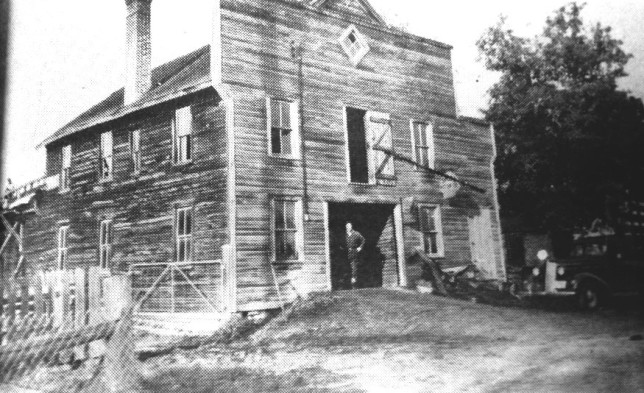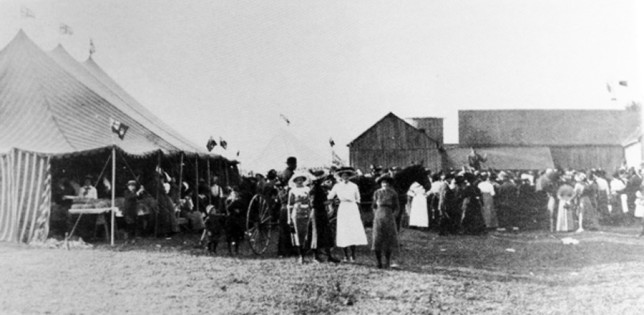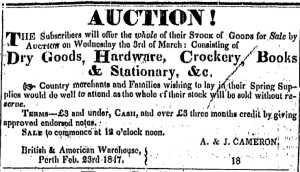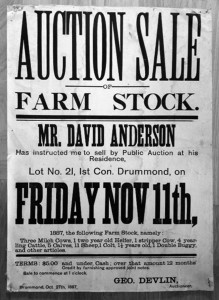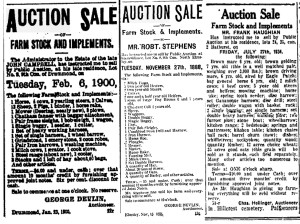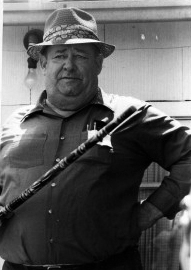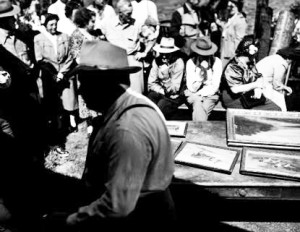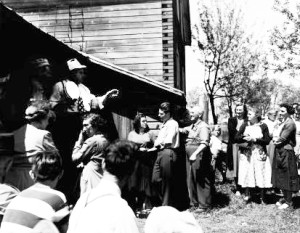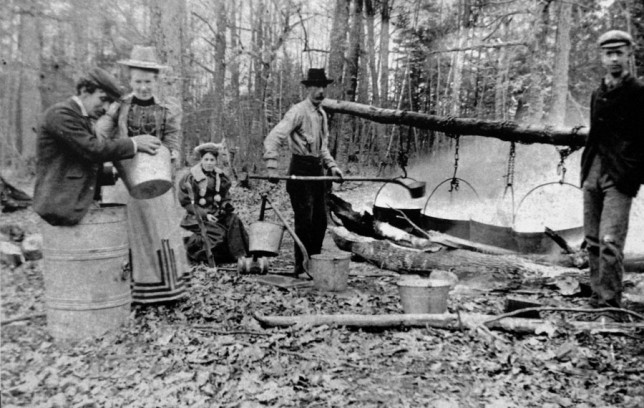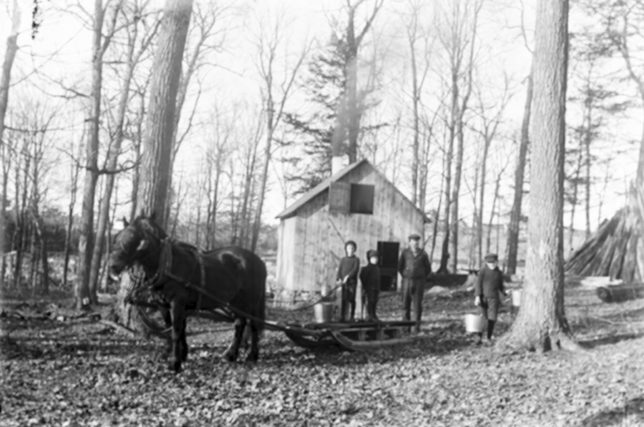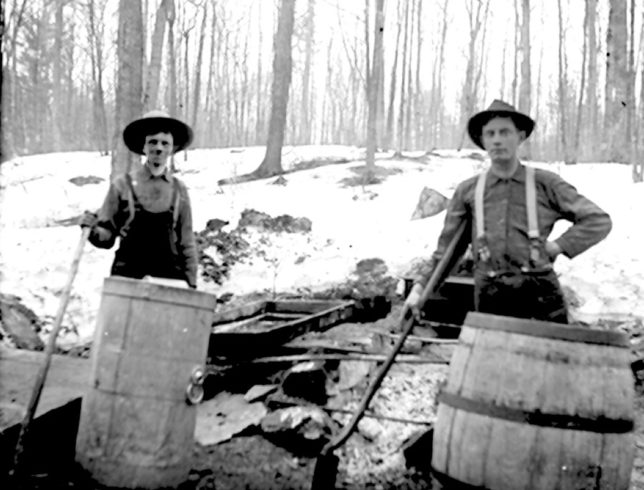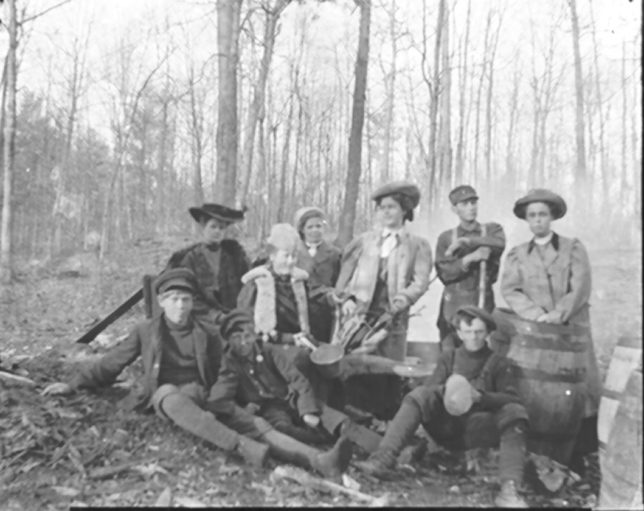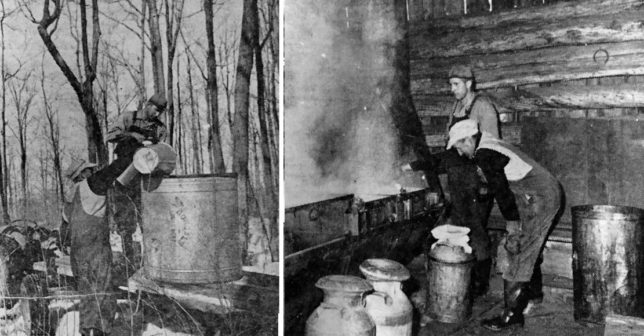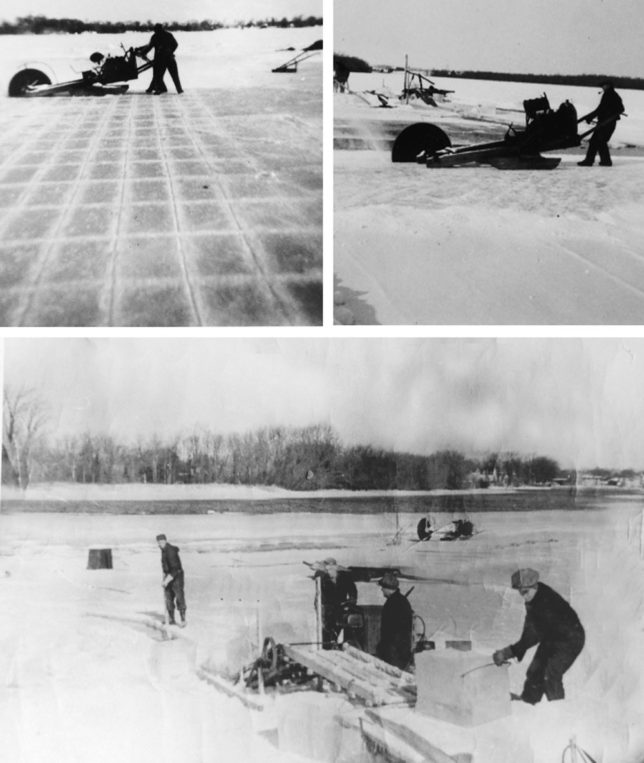FAMILY PICTURE ON THE EMON FARM SOUTH OF CALABOGIE
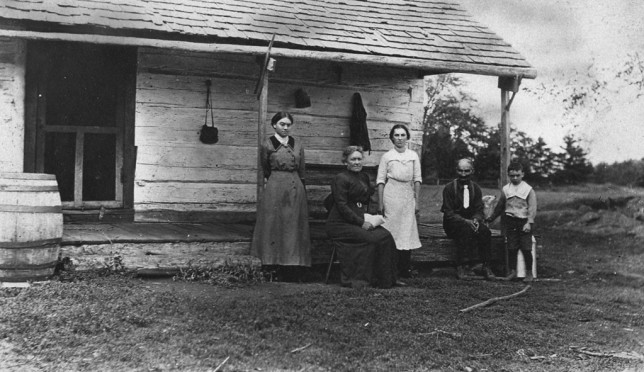
Kate Emon, Mary Emon (Somerville from Middleville), Evie Emon, “Watty” Emon, Roy Emon. Great Grandfather and Great Grandmother of the author of this site, David Bromley.

Walter Bromley at the farm c.1914. Mary (Sommerville) and Walter Emon Easter Sunday. “Uncle Watty” Walter Emon heading in from chores. Photos: David Bromley
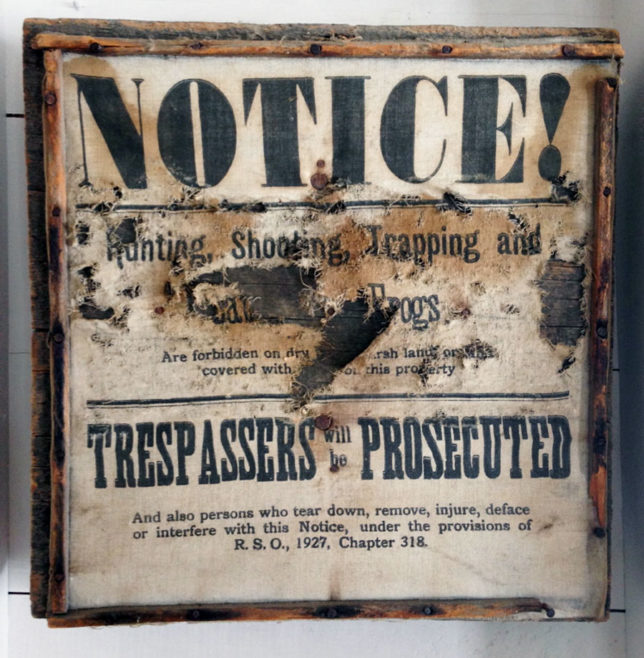
1927 NOTICE! Hunting, Shooting, Trapping and Bagging of Frogs are forbidden. Sign printed on burlap found in the bush in 1974 behind the Armour Farm of the Scotch Line on Ferrier Road. Courtesy David Bromley.
LIFE ON THE FARM
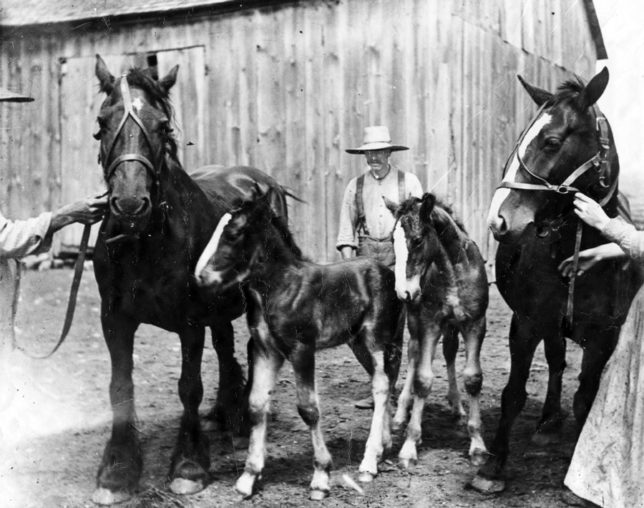
Matt Peacock, Rosetta. 2 Horses with 2 Foals. Photo from the Borrowman Collection, courtesy The Middleville Museum.
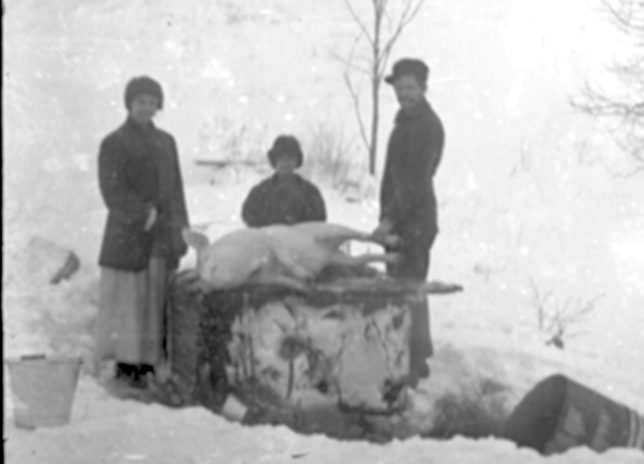
Dressing a pig, near Middleville. Photo from the Borrowman Collection, courtesy The Middleville Museum.

Sawing wood at Robert Charles Somerville’s Farm. Photo from the Borrowman Collection, courtesy The Middleville Museum.
PORTABLE SAWMILL 1919
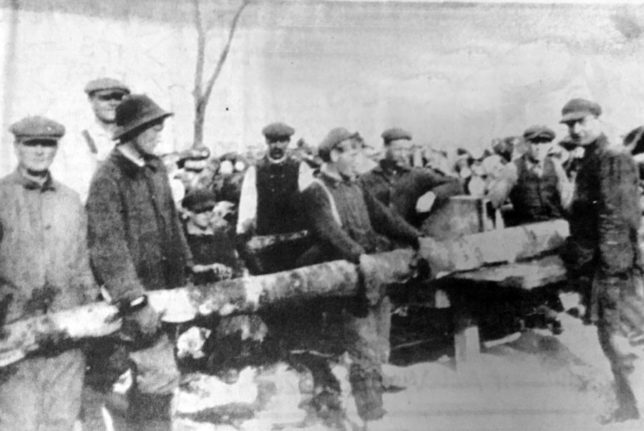
Cutting stove wood for the winter season was a chore that took a number of men and a portable sawmill. This photo was taken at the home of Bob Scott, and includes Sam Gibson (left), Jack Hendry, Earl Scott, Jim Dennison, Bob Scott, Lorne Scott, Lawrence Farrell and Andrew Allen. Photo courtesy Archives Lanark.
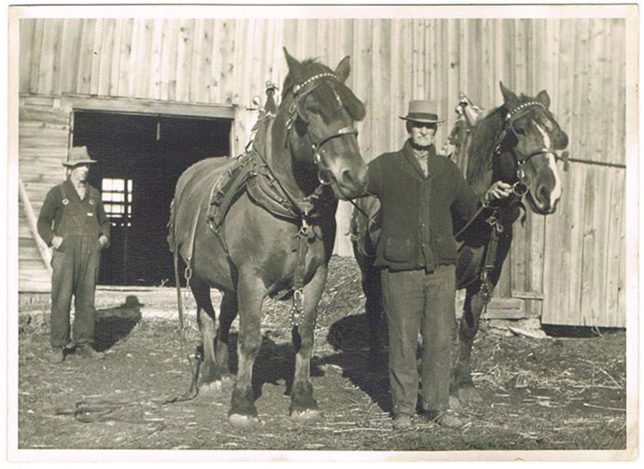
P.M.Campbell with the horses and Lindsay Campbell behind the horses, the horse barn at the fairgrounds is named after him. Photo Robert Campbell.
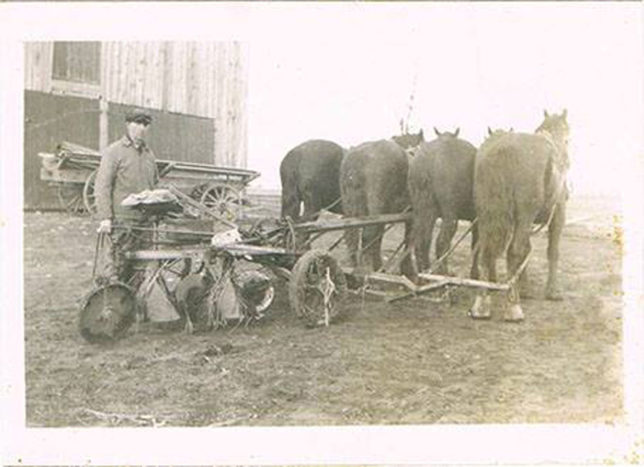
Lindsay Campbell, with a four horse team and two furrow plow which was a lot of horsepower in those days as a team of two and a one furrow plow was most common. Photo: Robert Campbell.
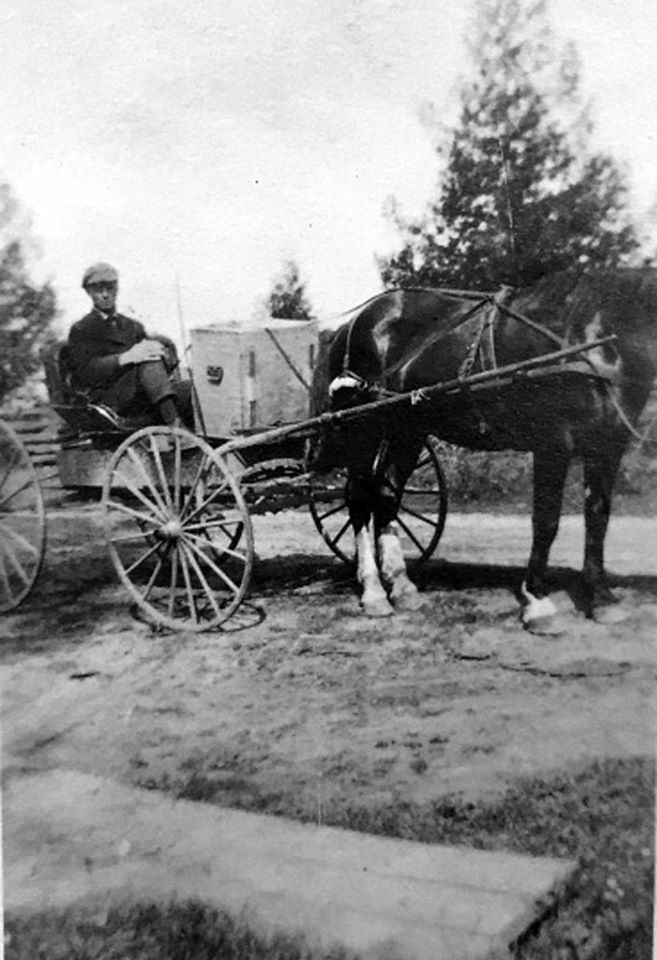
RURAL MAIL DELIVERY c.1914 NEAR BALDERSON.
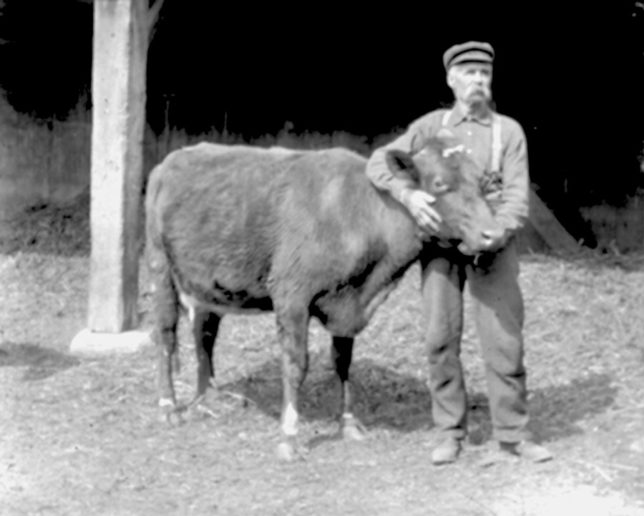
William B. Affleck with $500 cow. Photo from the Borrowman Collection, courtesy The Middleville Museum.
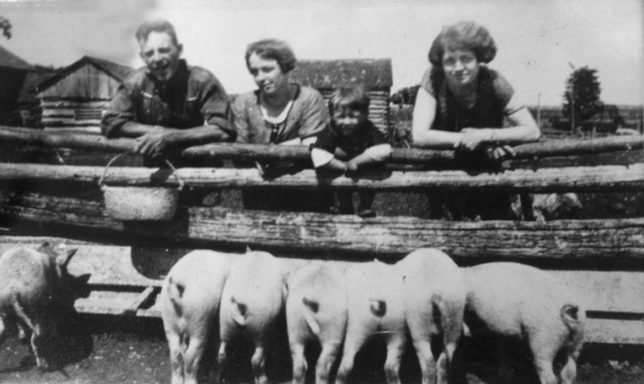
1926. Earl Manson, Agnes Manson, Kenneth Manson, Betty McKay. Photo courtesy The Middleville Museum.
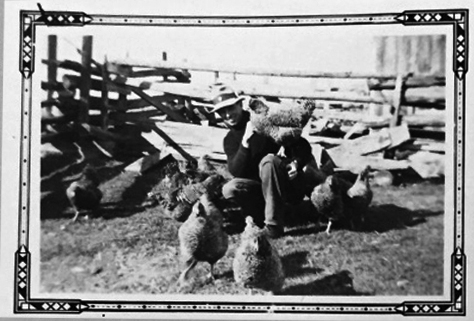
George Bell, son of Ernest Bell, Balderson, Ontario; a graduate of the OAC, Guelph, who served as the Agricultural Rep at Woodstock, Ontario, asked Clyde Bell to take part in a poultry testing project. 25 baby chickens from Herb Miller’s Poultry Farm at Glen Tay were provided free of charge. The amount of chick starter, and chicken grower consumed by the chickens was recorded weekly. Starting at six weeks of age, five banded birds were weighed each week, and the weight recorded. Clyde was the top scoring poultry judge in the Junior Farmers Judging Competition at the Central Canada Exhibition held in Ottawa, August 23rd, 1937, with a score of 198 points out of a possible 200 points. This explains why he was asked to take part in the project, which included a 25% refund on the price of the grower purchased and fed to the chickens. The birds became great pets and would follow Clyde and his mother, Barbara Bell, around the yard. Mr. Miller gave an extra chicken, and all 26 birds were brought in from the range in October. They were kept in a separate pen. A record was kept of the food consumption and egg production for a six month period. George had worked for a feed company at Brooklin, Ontario, for a short period of time.
BARN RAISING 1886
Barn raising, on the farm of J.D.Moodie, Scotch Line, June 30, 1886. On beam at top, sitting: Jas. Ferrier, John Ferrier Sr., John Palmer, Jas. Robinson. Standing: Robt. McLaren, Abram Ferrier Jr., Harry Acheson, Isaac Ferrier, Alex Moodie, Robt. Strong. Sitting: John McDonald, Albert Wilson, Home Boy (Name not known), Alex Dodds, Jas. D. Allan, Robert Brash, Jas. Wilson. Sitting on beam beside ladder: Jas Cameron, Blacksmith, Fallbrook. Middle beam, standing at left: Andy Turnbull, John Ferrier. Middle beam, sitting at right: R. Davidson, Abe Moodie, Frank Allan Sr., name unknown. Standing on Barn Floor: Geo. Farnell (ed. sitting on chair), Jas. Fraser, Abraham Ferrier Sr., Mac Ferrier, Robt. Allan, Rathwell, Manitoba, Robt. Moodie, Frank Allan Jr., Jas. Moodie, John Allan, Od. Consitt, Chas. Walker, John Armour. Between rows: Wm. Acheson, John Moodie. Sitting on Gangway: T.A. Moodie, John McGowan, Matt Balderson, Issac Ferrier Sr., Barney Hogan, Alex Abercrombie, Sloan (first name unknown). Sitting far right: Jas. Moodie Sr., Wm. Cowie.
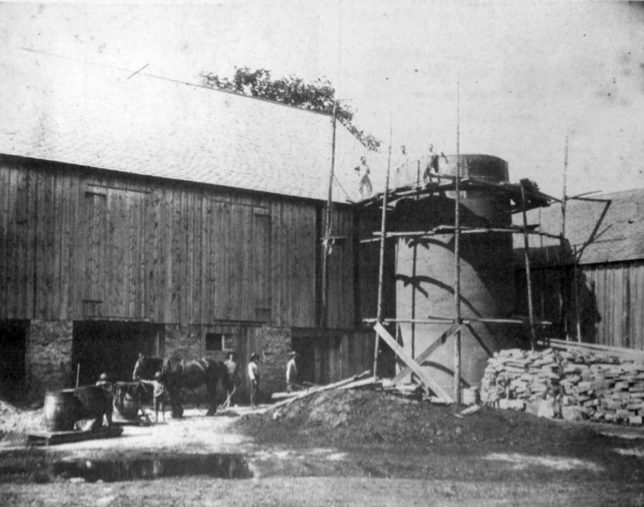
Building one of the first cement silos in the area. This silo was built in 1902 at Mervyn Ferrier’s Scotch Line farm. His father, James Ferrier, gave the contract for building the silo to James and Reid, agents for Portland Cement, who brought the three workmen from St. Mary’s to erect the silo. The three men behind the horse are Jim Steele, John MacDonald and John Ferrier. Photo courtesy Archives Lanark.
WOOD SAWING BEE
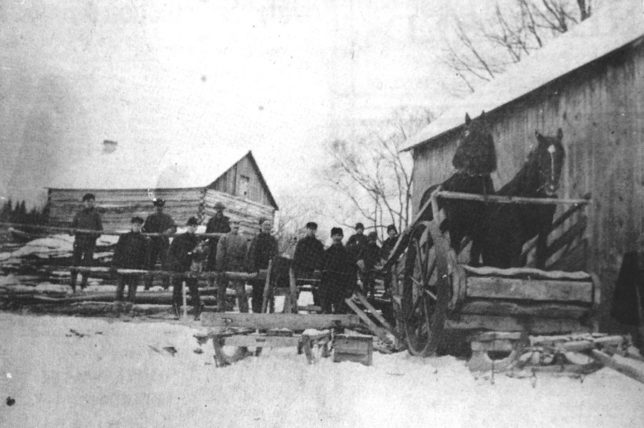
Wood sawing bee at the farm of Sam Gordon, one mile east of Elphin in the early 1900’s. Several neighbors are shown here, holding the long logs up to the circular saw, which was powered by the two horses on the tread-mill shown at the right. This wood-sawing outfit was owned by Dunc McLellan of the Highland Line, who went from farm to farm throughout the winter sawing wood, yet never more than 15 miles from home. A day’s pay was $1.50 for himself, his team and outfit, and he operated his sawing business from 1898 until 1910, when a gasoline engine replaced the horses. Photo courtesy Archives Lanark.
THRESHING MACHINE c.1914 FRANKTOWN
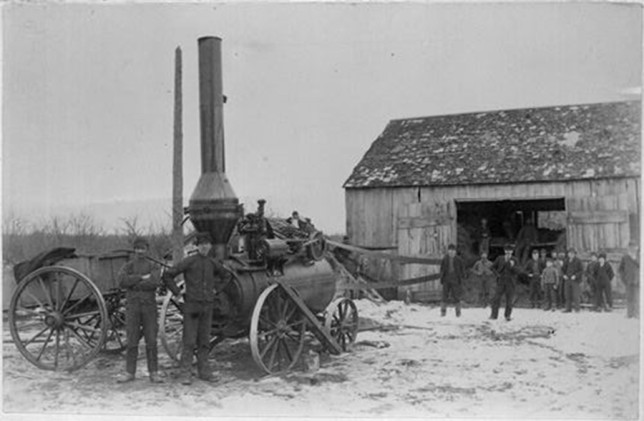
Threshing machine with a steam engine. C.1941 Franktown Ontario. C224-6. ©Queen’s Printer for Ontario
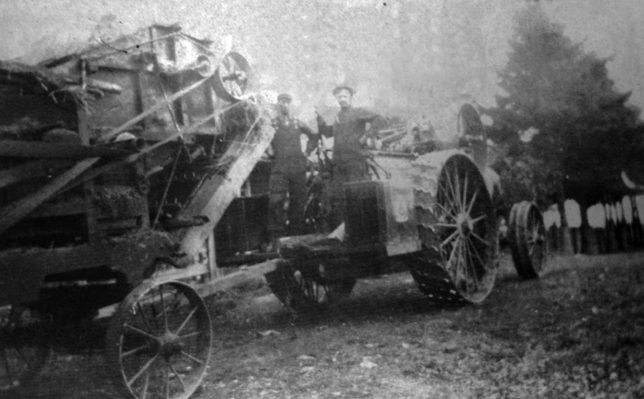
Grain Threshing Scene c.1916. This threshing mill was used by Henry Lewis and his son, Walter Lewis, who did custom threshing throughout Drummond Township for several years. The mill was powered by a large Waterloo 20 HP Steam Engine. Wood was used for fuel to fire the boiler, and it would take about an hour each morning to get up steam pressure to run the threshing mill. Photo courtesy Archives Lanark.
FARMERS REMOVING ROCKS FROM FIELD
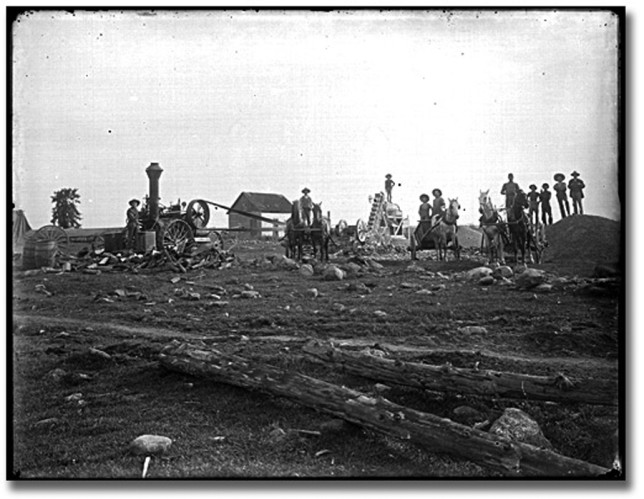
Eastern Ontario, [between 1895 and 1910] Bartle Brothers Glass plate negative Reference Code: C 2-10232-1731 Archives of Ontario, I0002528. © Queen’s Printer for Ontario, 2015.
FARMERS MOVING HAY INTO A BARN

[between 1895 and 1910] Bartle Brothers Glass plate negative Reference Code: C 2-10232-1729 Archives. © Queen’s Printer for Ontario, 2015.of Ontario, I0002526

Final day of harvet in 1904 at ELMEW FARMS. 8 horse power, 17 man power and unrecorded kitchen power.
IMMIGRATION POSTER
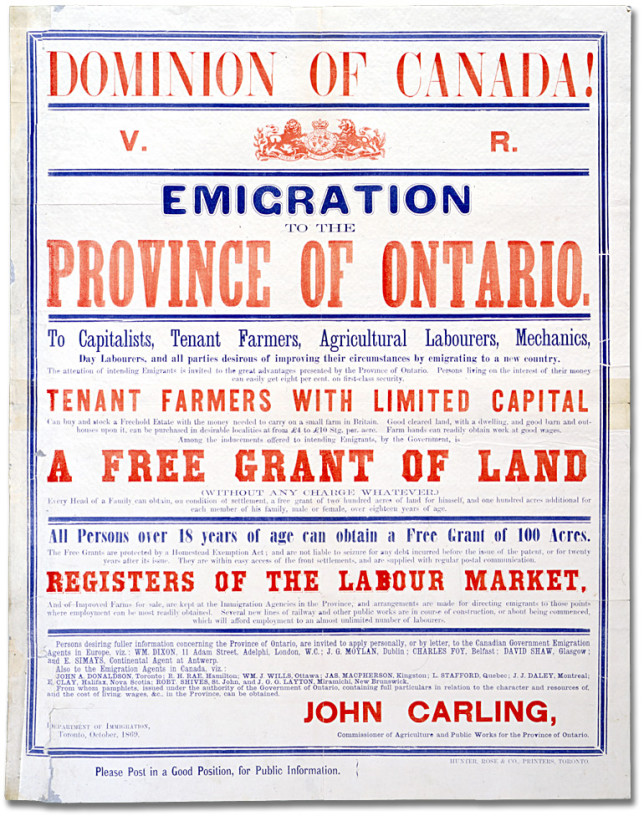
Emigration to the Province of Ontario, 1869 Department of Immigration Reference Code: C 233-1-5-1938 Archives of Ontario Poster collection ©Queens Printer for Ontario
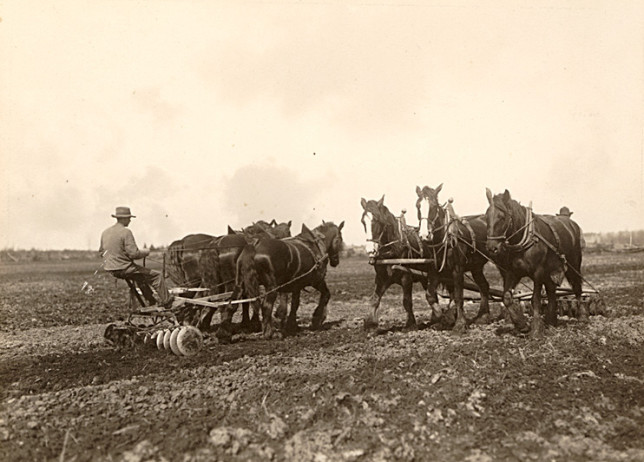
Disking a field, 1910 Reuben Sallows Black and white print Reference Code: C 223-3-0-0-9 Archives of Ontario, I0002270 ©Queens Printer for Ontario
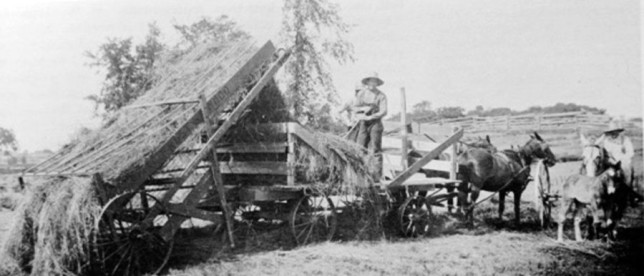
Robert Affleck to the right at the rake and his new hay loader, near Middleville. On the loader is Alden Affleck and Wylie Affleck. Hay loaders of this type were pulled by horses or a tractor trailed by a hay wagon. Driven by the wheels and a chain, hay would be picked up from windrow and then moved up the loader by the wooden bars with steel fingers. Workers forked hay onto the rack until the wagon was filled. This is a Frost and Wood hay loader that was manufactured in Smiths Falls Ontario. Picture c.late 30s early 40s. Public Archives of Canada
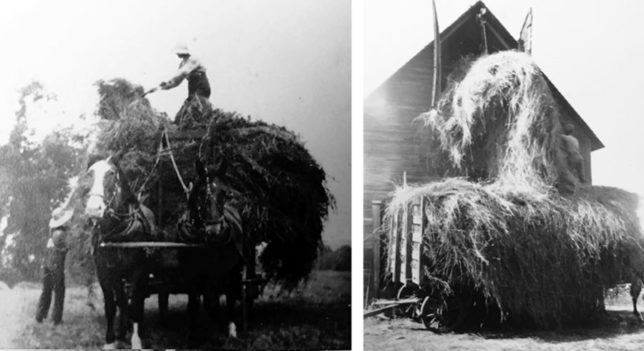
Near Balderson, Jack and Clifford Fulton loading hay onto the hay wagon then from the haywagon to the hayloft. Photo courtesy Archives Lanark.
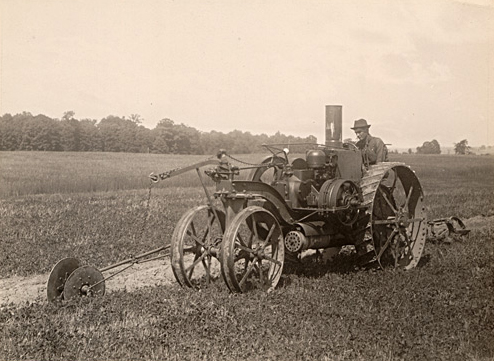
Using a gas tractor and gang plow, 1916 Reuben Sallows Black and white print Reference Code: C 223-3-0-0-3 Archives of Ontario, I0002264 ©Queens Printer for Ontario
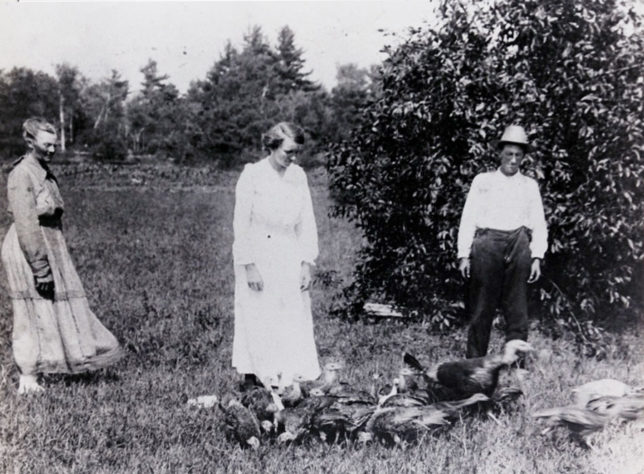
“Hearding Turkeys”. Mary, Mina and Harry Richards with a flock of turkeys. They used to drive them to a neighbouring pasture for food.Photo courtesy Archives Lanark.
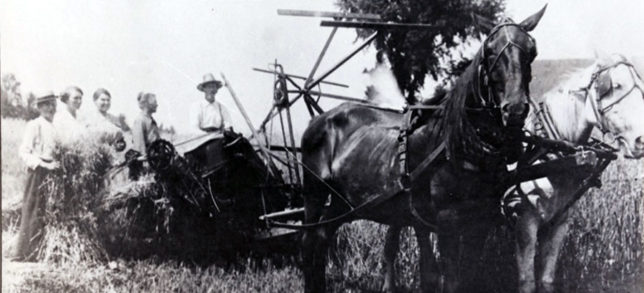
Charlie, Mina Richards, Becky Pelletier, Mary & Harry Richards with sheaf of grain from binder. Photo courtesy Archives Lanark.
LOGGING IN LANARK COUNTY
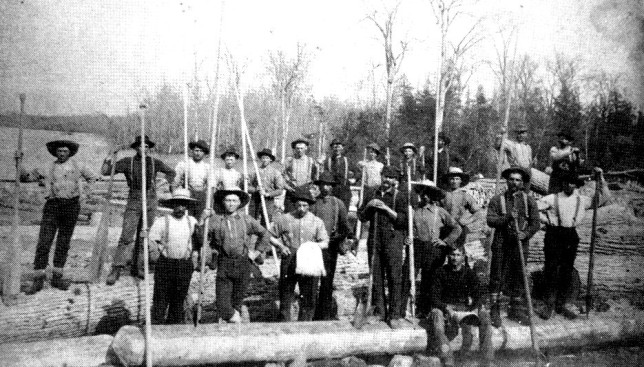
LUMBERING ON THE MISSISSIPPI. This picture was taken at Innisville around 1900, and shows a group of lumbermen with peaveys (pike poles) and cant hooks which they used to bring rafts of logs down the Mississippi to mills at Carleton Place. The boom logs were opened above the rapids and when the logs had floated down, they had to be rounded up and again enclosed within the booms.
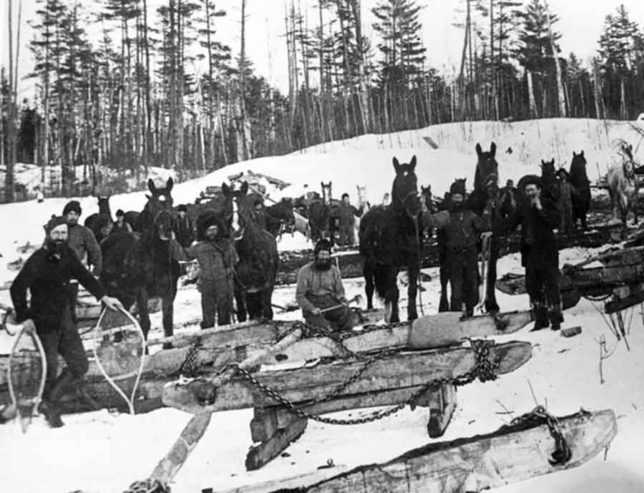
Lanark County logging. Hauling squared timber to rivers. Negative No. C19837, Public Archives of Canada.
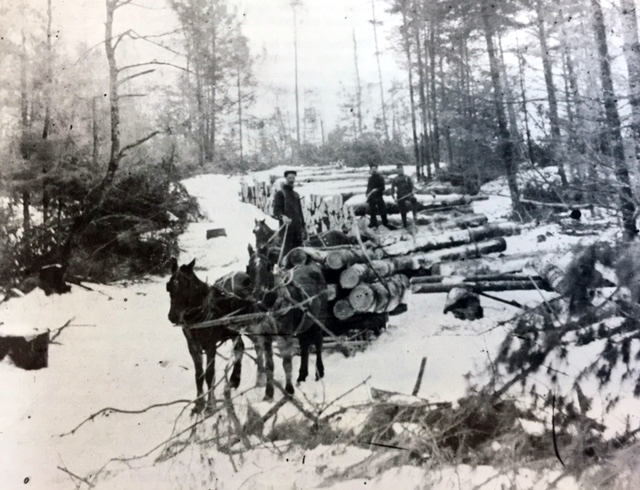
George Mather with a load of logs in bush lot, 1910. Quite apart from the lumber trade that was drawing to a close in the Mississippi watershed, individual farmers derived supplementary income by selling firewood from their bus lots to town inhabitants.
LANARK COUNTY CHEESE FACTORIES
The golden age of the rural co-operatively run cheese factory in Lnark County extended from 1880 to 1920. Milk could not be transported long distances, due to its perishable nature and the lack of refrigerated transport. To prevent inclement weather from playing havoc with the serious matter of weighing one’s milk at the factory door, rural cheese factroies incorporated an overhang to protect the farmer and his horses.
SCOTCH LINE CHEESE FACTORY c.1910
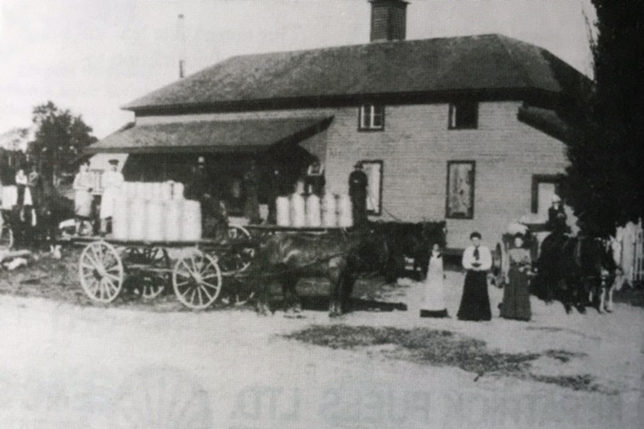
Wearing a white apron and standing beside a row of milk cans is the cheesemaker, Ben Avery, with his assistant. On the wagon at the left of the picture is James Gibson and his nephew, John A. Gibson. Among the tree women at the right of the picture are Mrs. Sarah MacLennan and Mrs. James Allan. The building accidentally burned about Christmas, 1913 and replaced with a similar building which was in use for another 50 years until it was also destroyed by fire on Novemeber 9th, 1965, with an estimated loss of $40,000. The site became the location for Cliff Kelford’s Auto Parts.
SCOTCH LINE UNION CHEESE FACTORY 1932
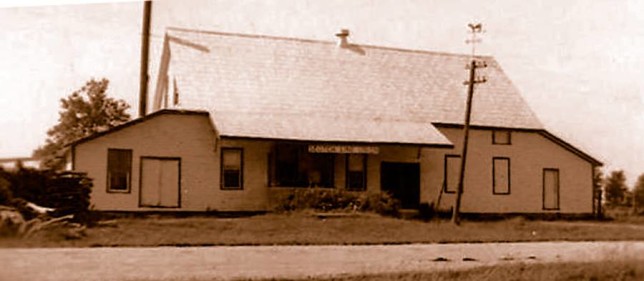
In 1893 this cheese factory along with 12 other area cheese factories was involved with the creation of the Mammoth Cheese that went the Chicago Worlds Fair in 1893. The Cheesemaker at the time was John Wiltsie.
HOPETOWN CHEESE FACTORY
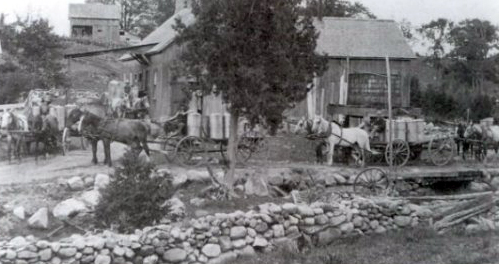
The farmers weighed their milk under the protective roof on the left. The round whey tank is on the right. Built in 1884, the factory served the community farmers until 1933. Photo: Middleville and District Museum.
MIDDLEVILLE CHEESE FACTORY
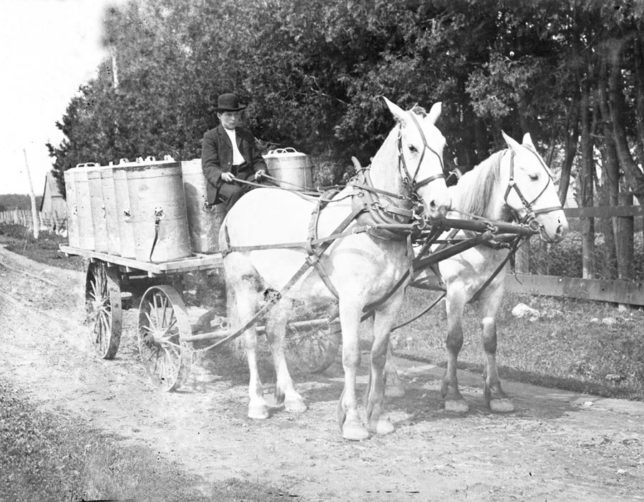
Timothy Sweenney with William Langstaff’s Team hauling milk to Middleville Cheese Factory. Photo from the Borrowman Collection, courtesy The Middleville Museum.
FALLBROOK CHEESE FACTORY
HARPER CHEESE FACTORY
POLAND CHEESE FACTORY
BALDERSON CHEESE FACTORY
The Balderson Cheese Factory dates back to 1881 and was named after the village of Balderson which was originally founded by Sergeant John Balderson of the British Army. This company was created by fifty one milk shippers who collectively decided to form a dairy co-operative and build their own cheese factorywhich would provide them with a reliable and local market for their milk.The Balderson Corner’s cheese factory grew in popularity and prospered over the next decate. In 1892-93 it was one of twelve local factories that was selected to contribute in the making of the Mammoth Cheese which was Canada’s unique dairy display at the Chicago World’s Fair. The company’s development continued without any major setbacks until in 1929 the factory was destroyed by fire. Fourtunately the determination of the shareholders did not falter and rebuildin started immediately. Balderson cheesemakers: W. Brown 1881-1887, J. Milton 1888-1891, W.D. Simes 1892-1901, E.E. Haley 1902-1904, J.M. Scott 1905-1911, T.K. Whyte 1912-1917, M. Haley 1918-1921, A. Quinn 1922-1929, G. Spencer 1930, P. Kirkham 1931-1937, J.L. Prentice 1937-1939, C.J. Bell 1939-1941, J. Somerville 1941-1942, W. Partridge 1943, C. Gallery 1944-1955, R. Lucas 1956-1958, P. George 1959-1960, O. Matte 1961-1966, Y. Leroux 1966-1974, L. Lalonde 1975-1980, N. Matte 1980.
DRUMMOND TOWNSHIP CHEESE FACTORY
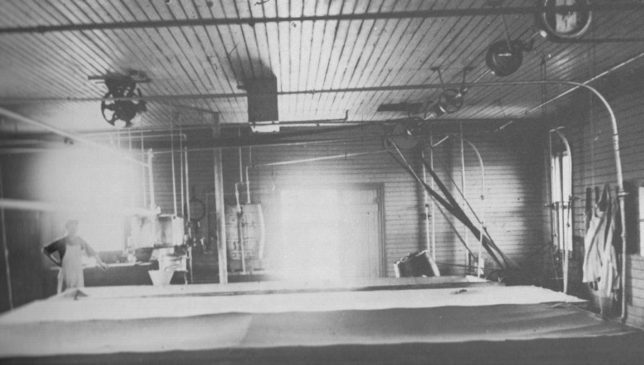
Inside Drummond cheese factory, Drummond Township, 1913. Large covered vats dominated the interior of cheese facgtories. The Drummond factory was one ot twelve to provide the milk that went into the mammoth cheese at Perth.
DRUMMOND CENTRE CHEESE FACTORY 1880
LONESTAR CHEESE FACTORY – PORT ELMSLEY
ROSEHILL CHEESE FACTORY 1899
ROSEHILL CHEESE FACTORY c.1910
BLACK LAKE CHEESE FACTORY
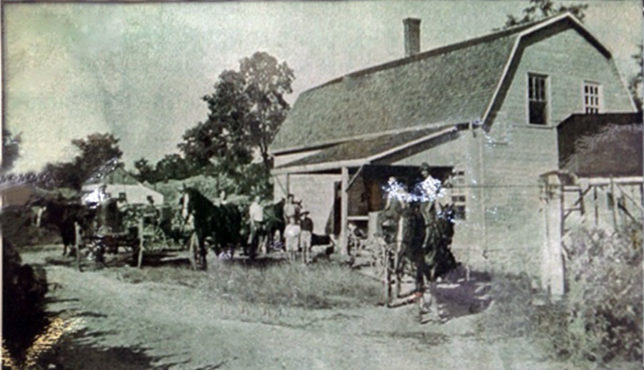
Located Narrows Lock Road at Black Creek. Owned by John WHite who also owned the Stanleyville Cheese Factory.
ALTHORPE CHEESE FACTORY
ROSEBANK CHEESE FACTORY
CHAPLINS DAIRY GLEN TAY
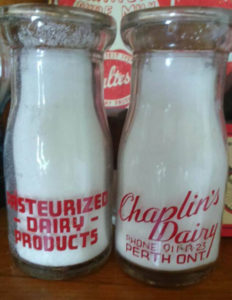 This 1920 photograph shows Edgar Chaplin, Uncle to John and Cameron Chaplin, pausing during a milk run with his horse and wagon. Edgar worked in the business with Delbert Chaplin. The price of a quart of milk in 1935 was 35¢ a quart. In the earliest days of the dairy, started by Delbert Chaplin, milk was distributed with a pint or quart measure by the “milkman” who simply ladled it out of milk cans into whatever container was left out on a front porch or stoop by the customer. The birth of the dairy evolved from a large 300-acre farm owned by the Chaplin family at RR4 Perth. Delbert Chaplin, a progressive man, set up a system so the farm could process its own milk produced by its Holstein cattle herd. He erected a dairy building at Glen Tay in 1935 and the business flourished from there and became a complete family enterprise. The dairy turned out as many as 3,000 quarts of milk a day during the diary’s peak production years. They distributed throughout the Perth and district area. Chaplin’s Dairy also processed the milk supplied by five neighboring farms in order to keep pace with customer demand. Buttermilk and chocolate milk also left the dairy house for sale. Butter was produced too but never enough to be sold. Chaplin’s Dairy was sold in 1977 ending a family ownership of close to 70 years. Story from the Perth Courier.
This 1920 photograph shows Edgar Chaplin, Uncle to John and Cameron Chaplin, pausing during a milk run with his horse and wagon. Edgar worked in the business with Delbert Chaplin. The price of a quart of milk in 1935 was 35¢ a quart. In the earliest days of the dairy, started by Delbert Chaplin, milk was distributed with a pint or quart measure by the “milkman” who simply ladled it out of milk cans into whatever container was left out on a front porch or stoop by the customer. The birth of the dairy evolved from a large 300-acre farm owned by the Chaplin family at RR4 Perth. Delbert Chaplin, a progressive man, set up a system so the farm could process its own milk produced by its Holstein cattle herd. He erected a dairy building at Glen Tay in 1935 and the business flourished from there and became a complete family enterprise. The dairy turned out as many as 3,000 quarts of milk a day during the diary’s peak production years. They distributed throughout the Perth and district area. Chaplin’s Dairy also processed the milk supplied by five neighboring farms in order to keep pace with customer demand. Buttermilk and chocolate milk also left the dairy house for sale. Butter was produced too but never enough to be sold. Chaplin’s Dairy was sold in 1977 ending a family ownership of close to 70 years. Story from the Perth Courier.
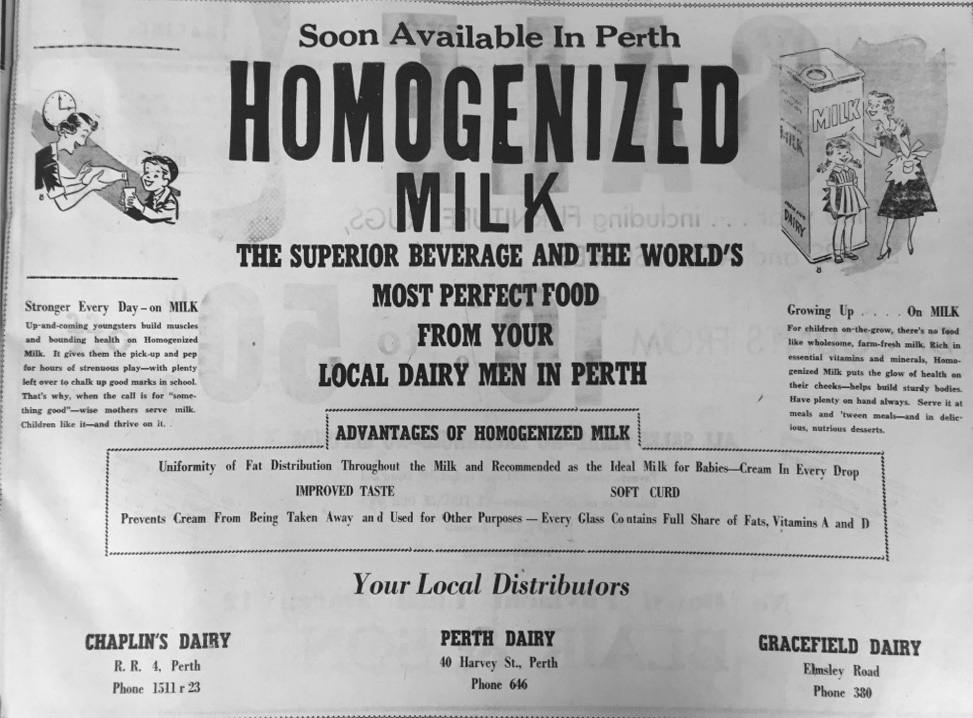
MILLS OF LANARK COUNTY
The following is an account by Mr. Archibald Campbell writes of an interesting tale of industrial effort when the settlement was young: AN ACRE OF HARDWOOD FOR ONE BARREL OF POTASH, Perth Courier, 1934.
To begin with, the clearing of the land with its attendant burning of the hardwood trees, produced large quantities of potash. Later on, in the autumn, after the harvest had been gathered in, and when the farmers had leisure, many of them utilized it making potash, for which there was a great demand. A barrel of potash brought $35 or more, but, as the huge iron kettle cost about $40 many were prevented from engaging in this operation. It took about an are of good hardwood to produce a barrel of the fertilizer. Great quantities were purchased by the early merchants of Perth, hauled to Oliver’s Ferry and Brockville and shipped by boat to Montreal. This industry flourished between 1817 and 1834 – when lumbering operation got under way, furnishing speedy, congenial and fairly profitable employment to the surplus male population.
PERTH’S SQUARE TIMBER. IN the thirties and forties of last century much fine square oak timber was shipped from the Perth Basin to Montreal, en route to England. It had tone rafted with enough pine timber to keep it afloat and wen via the Tay to the Rideau and on to Ottawa and Montreal or Quebec.
EARLY SAW MILLS. Dr. Thom’s mill, built about 1820, was sold to Mr. John Haggart Sr. in 1833. About 1876 it was destroyed by fire. In 1873 the brothers, James and Alexander Allan, who had operated the Haggart mill for a year built a steam saw mill in Carolin Village. In addition to sawing lumber they manufactured barrel staves, hoops and heads. By 1846 there were 31 sawmills in Lanark County.
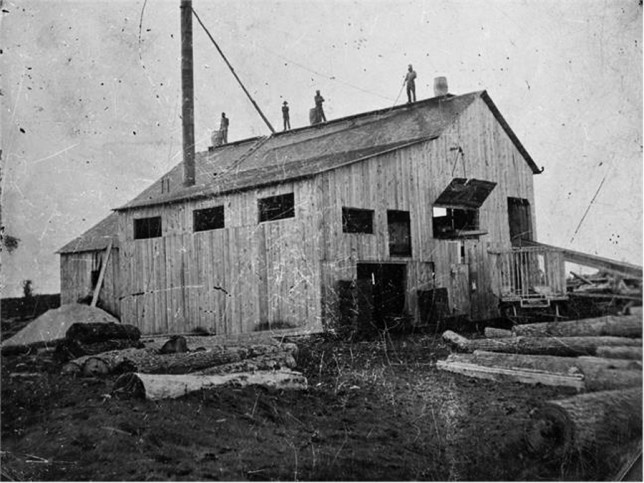
Saw mill, grist and shingle mill established by Isaac Currie 1860 on the Fall River. Maberly. Photo: Library of Archives Canada 1870.
PENMAN’S SAWMILL MIDDLEVILLE 1910
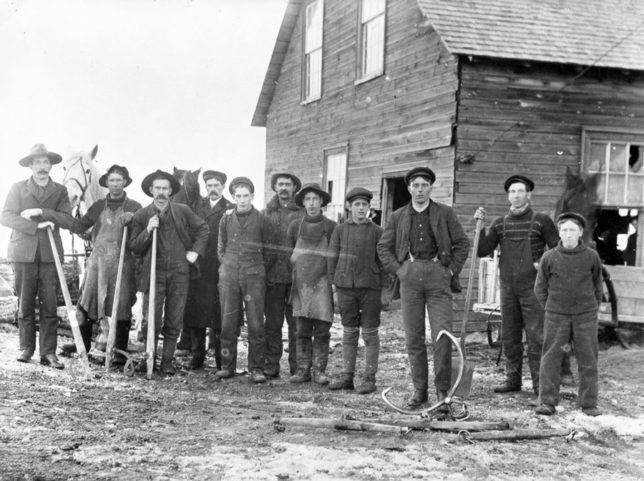
: J. Penman Sawmill Gang 1909. Peter Barr, Fred Woods, R.L. Somerville, J.C. James, Allie Blackburn, Jim Penman, Bobby Somerville, Rex Penman, Mel. Woods, Jack Miller, Willie Wilson. Photo from the Borrowman Collection courtesy the Middleville Museum.
FERGUSON’S FALLS SAWMILL
ANDERSON’S SAW MILL FALLBROOKE
SAW MILL AT ROBERTSON’S LAKE
ADAM’S MILL / RITCHIE’S MILL
ALLEN’S MILL
Allan’s Mills, named for William Allan, was a small milling hamlet located just west of the town of Perth in Lanark County. The community got its start after Allan built saw and grist mills, followed by a general store and blacksmith shop. A post office was opened in 1872.
At its height, Allan’s Mills included a wagon maker, shoemaker, carpenter and two blacksmiths. The surrounding area was dotted with other small mills that included the McCabe Mill, the Ritchie Mill and the Bowes Mill. A school located on the Scotch Line was shared by all the surrounding settlements.
By the late 1890s, business was beginning to slip. Timber supplies had become depleted and farmers were making a gradual transition from wheat to dairy farming. Many of the mills did not survive the upheaval.
BOWES MILL
ADAM’S MILL
For more historical information on the Mills of Lanark County visit:
The Mills of the Tay Watershed and Immediate Area of Eastern Ontario compiled by Larry Turner
BLACKSMITH SHOPS
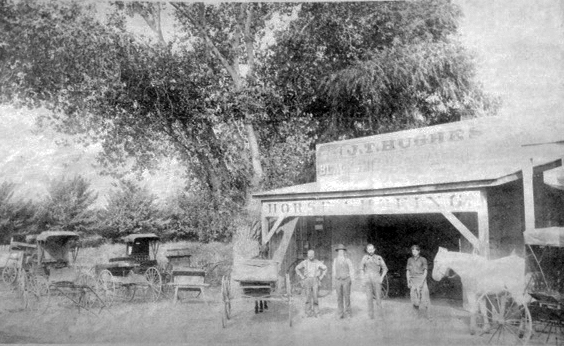
J. T. Hughes blacksmithing shop at Innisville. Photo submitted to the Perth Courier, 1984 by Mr. Crampton
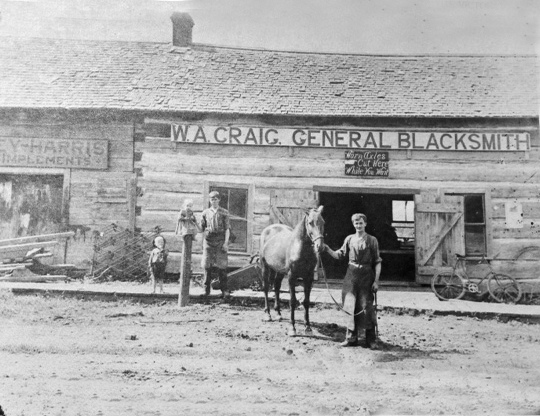
Craig’s blacksmith shop, Hopetown. c. 1904. Photo: Public Archives of Canada, Negative No. PA-079039.

Robert Charles Somerville’s blacksmith shop. Photo from the Borrowman Collection, courtesy The Middleville Museum.
FALLBROOK FAIR
FARMER’S LOG BRIDGE
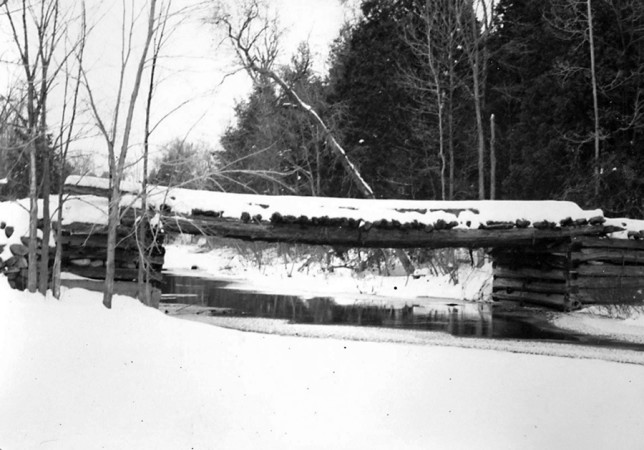
Common site on many farms in Lanark County. This bridge is over the Clyde River. Photo ©David Bromley 1979.
COUNTRY AUCTIONS
Thomas Rutherford Clayton Hands ( Nov. 2, 1915 – Sept. 7, 1980) pursued a career in auctioneering. He established a livelihood in 1938. For 40 years Clayton called square dances and conducted auctions as well. During that time frame he married wife Reta and they had seven children (2 boys & 5 girls). Reta was very busy looking after their children, phones and farm chores. When it came to auctioneering, Clayton had a strong voice that carried well outdoors as well as in buildings. He also possessed wit, charm and a personality that controlled large crowds. He acquired strengths in salesmanship and in the knowledge of articles and their values. He sold everything and anything – household effects, farm machinery, livestock, real estate, tools of the trades and so on……. On June 28, 1954, a documentary film ‘The Country Auctioneer” produced by the National Film Board, depicted Clayton Hands, a Canadian, in this interesting and important job.
THE SUGAR BUSH
THE MATHER SUGAR CAMP c.1900
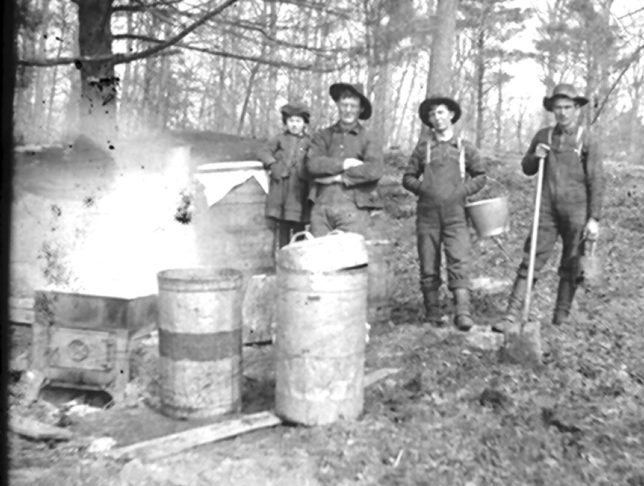
Elva, George Mather, Evan Craig, Bob Nairn. Photo from the Borrowman Collection, courtesy The Middleville Museum.
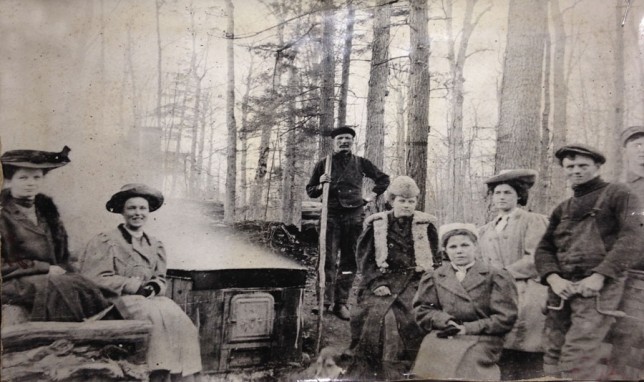
M. Blackburn, E. Somerville, Jack Mather Sr., M. Mather, L. Chambers,E. Somerville, J. Rankin, J. Mather.
WESLEY BORROWMAN SUGAR CAMP, MIDDLEVILLE c.1900
RANKINS SUGAR CAMP
MAPLE SYRUP ON THE SCOTCH LINE 1962
These pictures and story from a 1962 edition of the Perth Courier show Pat Brady of the Scotch Line and his cousin Don Brady of RR3 Perth working hard in their nearby camp. Pat Brady was quoted, “It’s a nice day. The wind is blowing south-west, just the way we expected.” Don agreed, “The weather is the most important factor in this business. The temperature must be 25 degrees at night and as high as the 40’s in the daytime. If the weather stays like that, the trees seem to run much better.” The evaporator they were using was built 25 years ago by Matt Dodds. The sugar camp itself is forty years old. Pat Brady explained that the evaporator, which he has been using for twelve successive years, is 12 feet in length and three feet in width. It contains three pans, which are always filled with sap. A maple syrup thermometer is used to measure the right degree of temperature. When the thermometer climbs to 219 degrees Farenheit it means the syrup has reached the right grade, or to be more specific, Mr. Brady gets 13 pounds and three ounces of maple syrup. Thirty to forty gallons of sap (after the evaporation) produces just one gallon of pure maple syrup. At the Brady Camp, they have tapped six hundred and sixty trees and they still do it the old way and have not modernized their camp. In 1961, they sold 125 gallons of syrup in Perth, Ottawa, Prescott and Toronto. The work at the camp was like a full-time job with chores that included gathering the sap, keeping the fire at a constant level and tapping the trees, but the most important aspect is to look after the evaporator to see that it doesn’t boil. “It’s just like having a day’s work in the kitchen.” thought both men, while constantly dropping an ey on the syrup making machine. “Pans, sap and syrup…all over the place, but it’s fun, though only for two or three weeks every year.” Concluded Patrick Brady, who owns the camp.
ICE CUTTING ON THE MISSISSIPPI
One of the necessary tasks before electricity or later deep freezers was cutting the ice in winter to ensure a good supply of frozen blocks to be available in the warm weather. Picture to the left shows Hollie Lowry cutting the ice on the Mississippi River and shows the ice that has been marked off, marker to the right in the picture, and then the huge cutting machine cutting through the ice. Picture to the right shows Hollie, smoking a pipe, cutting the ice close to shore. Bottom picture shows the blocks of ice loaded onto a conveyer belt then with ice tongs hauled onto the flat bed of sleigh ready for transport to the ice house. I remember the ice house off Rogers Road at the end of John Street by the river. Remember going in there with my Dad in the summer time and mind how cold it was. The ice blocks were covered in sawdust to protect the ice from the heat of summer. I also remember the day it burned down in the early 1960’s. There was also an ice house off Beckwith Street near the location of the curling rink. Who remembers ice being delivered to their home to keep their ‘ice box’ cold?
